
Updated 2024 Approved On the Level Expert Tips for Stabilizing Video in After Effects

On the Level: Expert Tips for Stabilizing Video in After Effects
Stabilize Shaky Videos After Recording Easily
Wondershare Filmora is one of the most popular video editing software among YouTubers , which provides the video stabilization tool to remove shake from videos within one-click. Download and have a try now.
Video content is becoming increasingly popular; with the proliferation of online content, practically every product now needs its mini-documentary or video clip. Experienced filmmakers and VFX artists used to be the only ones who could get smooth footage. Those days, however, are over.
Adobe After Effects is an excellent tool for smoothing out video footage, in addition to being a great blending and motion animation software; although it’s usually preferable to maintain your film as seamless as possible on location, it’s not the end of the world if you take a seat to edit your video and decide it’s too shaky. In truth, there are several options available to you. In After Effects, there are three options for stabilizing footage. What are they – and how to use After Effects to stabilize footage? Let’s find out!
In this article
01 Stabilize Video with Built-in Warp Stabilizer in AE
02 Stabilize Shaky Video with Track Motion Feature in AE
03 Using Stabilization Plugins for Smoother Video in AE
Part 1: Stabilize Video with Built-in Warp Stabilizer in AE
The Warp Stabilizer effect is a new technique to cope with unsteady video. In this part, I will show you how to apply Warp Stabilizer to a layer, adjust the effect’s essential parameters, and demonstrate how they work briefly.
Step 1: The Warp Stabilizer is the most excellent built-in choice for After Effects. This may be found under the Distort tools section of the Effects & Presets panel. You may also go to the effects tab and look for “Warp“ in the search box.

Step 2: When you’ve identified Warp Stabilizer, you’ll have to add it to the layer you want to stabilize. You may accomplish this in one of three different ways. You may either drag and drop the filter into the chosen layer in the composing window, place it on the desired layer in the timeline, or double-tap on the effect while selecting your choice footage layer.

Step 3: Once you apply the warp stabilizer, it will start immediately. So now, all you have to do is lay back and let the stabilizer do its job.
(Note: The procedure should take no more than a few minutes, and a blue bar will appear across your composition window, indicating that the warp stabilizer is evaluating the film. The composition panel would then display an orange bar, indicating that the effect is applied).
Step 4: After stabilization, use the spacebar to begin a RAM peek. Choose the layer you added to and click to display the drop-down menu or go to the Effects Control panel whenever you need to tweak the stabilizing effect.
Part 2: Stabilize Shaky Video with Track Motion Feature in AE
Using Stabilize Motion feature to stabilize video is an old-school heritage function from the era of the Creative Suite, it will still be there in After Effects presently and performs admirably.
Step 1: The tracker panel is most likely open by default in your edition of After Effects, but if it isn’t, go to Window in the top menu to open it. Once you’ve arrived here, scroll to the bottom until you locate Tracker and double-check that it has a checkbox beside it.
![]()
Step 2: Select Stabilize Motion from the drop-down menu whenever the tracker panel is open. You’ll see that a tracker box appears in your Layer Panel once you’ve done this.
(Note: You’ll need to identify a proper location in your film for the tracker to operate at this stage. We’re monitoring a vehicle using a camera operator’s drone in the instance below).
![]()
Step 3: Let’s press the Play button on the tracker panel once we’ve set up the tracker box. The tracker box should adhere to the location or item you chose when you do this.
(Note: When your tracking points start to go astray, use the Pause button, personally modify the tracking point, and then push play to resume the journey).

Step 4: When the tracker is done and satisfied with the results, click Edit target to verify that the tracking data is transferred to the correct layer. Then proceed to the bottom of the page and click the Apply option.
(Note A dialogue window with choices for applying them. Usually, you’ll want to choose X and Y here).

Hit the spacebar to evaluate how well the stabilize motion tracker performed now when you’re back in the composition window. When you’re not pleased with the outcomes, you might have to go back to try again. Although this approach is best used for photos with a clear point of focus that doesn’t go out of frame, it could still be helpful in some situations.
Part 3: Using Stabilization Plugins for Smoother Video in AE
As a graphic and motion designer, animator, or 3D artist, After Effects plugins may completely change the way you operate. Since it can handle so much right out of the box, Adobe After Effects CC is already a go-to motion graphic and compositing program for many artists.
However, as with any good program, third-party plugins could only help you take your work to the next level by adding new features or streamlining your process.
It should be unsurprising that After Effects has many plugins for a program that is over 30 years old. Here are the best stabilization plugins for smoother video in AE:
1. Orb
Orb is focused on generating realistic planets and includes a range of unique features to make planetary creation easy. It utilizes a similar 3D engine to Video Copilot’s great Element 3D plugin, and it employs a similar 3D engine to Video Copilot’s outstanding Element 3D plugin.
You would believe that making planets in 3D is simple —create a circle, add textures, and you’re done! Getting a world to ‘look’ properly, on the other hand, might be more complicated than it appears.
For example, how can the line between night and day be altered in a model of a populated planet such that cities may be visible at night but not during the day?
Although Orb doesn’t work for every planetary picture, this would function for 90% of them and is a helpful previs tool. This is particularly true when used in conjunction with other After Effects plugins or paired with a 3D lens from a 3D program, which may be brought into After Effects with background plates for things like spacecraft.
2. Depth of Field Generator PRO (DOF PRO)
Richard Rosenman’s renowned Photoshop depth of field generator plugin, DOF PRO (Depth of Field Generator PRO), is now downloadable for After Effects. DOF PRO has become the industry’s professional option for an unprecedented and complex depth of field effects rapidly and effectively as a post-process.
This is thanks to almost a decade of discovery and application since the first launch in 2005. DOF PRO’s cutting-edge characteristics offer new and advanced technologies not found anywhere else, resulting in one of the industry’s most potent and sophisticated depth of field processors.
Capability for chromatic and achromatic aberration, focal plane bokeh distinction, astigmatism and vignetting effects, bespoke aperture maps, and noise recovery are among the advanced features.
There will also be compatibility with the alpha channel and transparency, 32-bit floating-point color, correct aperture displays, and an iris array display. A feature comparison between the plugin and After Effects’ Camera Lens Blur effect can be found here.
3. ReelSteady
ReelSteady for After Effects is a recent addition to the stabilization marketplace. ReelSteady is similar to After Effects’ warp stabilizer plugin. However, the stabilization in ReelSteady is far superior.
ReelSteady also has several other features that make it ideal for creating next-level tunes. Users may design filters to block off specific sections of your frame. This is useful for removing a subject that travels around the frame a lot.
In terms of performance, the After Effects plugin is pretty similar to the warp stabilizer but with a few more features. To begin with, ReelSteady includes a built-in rolling shutter repair tool that operates in tandem with its built-in stabilizer.
The ReelSteady effect is a two-pass effect. For instance, after the effect has been executed for the first time, you will likely wish to level out certain places. You’ll successfully isolate specific parts in the effect to “iron out” sections of the footage.
You would like to record your film at a more excellent resolution than your expected outcome to get the most out of ReelSteady. If you wish to output your video in 4K, you might capture it in 4.6K or 5K. You’ll have some leeway for ReelSteady to work its magic.
ReelSteady’s sole flaw is its high price ($399). ReelSteady is not available in After Effects, unlike some of the other choices on this list. ReelSteady, on the other hand, is the way to go if you would like the smoothest footage imaginable.
Conclusion
Shaky video footage would be the last thing any video creator wants unless it’s done intentionally for artistic or creative reasons. As a result, they employ methods and equipment to keep the camera safe from any undesired movement.
However, occasionally those tools aren’t available, and the outcome is questionable. That is why we decided to compile this article to add to the knowledge of our readers how they can use After Effects to stabilize videos to enhance their video content
Video content is becoming increasingly popular; with the proliferation of online content, practically every product now needs its mini-documentary or video clip. Experienced filmmakers and VFX artists used to be the only ones who could get smooth footage. Those days, however, are over.
Adobe After Effects is an excellent tool for smoothing out video footage, in addition to being a great blending and motion animation software; although it’s usually preferable to maintain your film as seamless as possible on location, it’s not the end of the world if you take a seat to edit your video and decide it’s too shaky. In truth, there are several options available to you. In After Effects, there are three options for stabilizing footage. What are they – and how to use After Effects to stabilize footage? Let’s find out!
In this article
01 Stabilize Video with Built-in Warp Stabilizer in AE
02 Stabilize Shaky Video with Track Motion Feature in AE
03 Using Stabilization Plugins for Smoother Video in AE
Part 1: Stabilize Video with Built-in Warp Stabilizer in AE
The Warp Stabilizer effect is a new technique to cope with unsteady video. In this part, I will show you how to apply Warp Stabilizer to a layer, adjust the effect’s essential parameters, and demonstrate how they work briefly.
Step 1: The Warp Stabilizer is the most excellent built-in choice for After Effects. This may be found under the Distort tools section of the Effects & Presets panel. You may also go to the effects tab and look for “Warp“ in the search box.

Step 2: When you’ve identified Warp Stabilizer, you’ll have to add it to the layer you want to stabilize. You may accomplish this in one of three different ways. You may either drag and drop the filter into the chosen layer in the composing window, place it on the desired layer in the timeline, or double-tap on the effect while selecting your choice footage layer.

Step 3: Once you apply the warp stabilizer, it will start immediately. So now, all you have to do is lay back and let the stabilizer do its job.
(Note: The procedure should take no more than a few minutes, and a blue bar will appear across your composition window, indicating that the warp stabilizer is evaluating the film. The composition panel would then display an orange bar, indicating that the effect is applied).
Step 4: After stabilization, use the spacebar to begin a RAM peek. Choose the layer you added to and click to display the drop-down menu or go to the Effects Control panel whenever you need to tweak the stabilizing effect.
Part 2: Stabilize Shaky Video with Track Motion Feature in AE
Using Stabilize Motion feature to stabilize video is an old-school heritage function from the era of the Creative Suite, it will still be there in After Effects presently and performs admirably.
Step 1: The tracker panel is most likely open by default in your edition of After Effects, but if it isn’t, go to Window in the top menu to open it. Once you’ve arrived here, scroll to the bottom until you locate Tracker and double-check that it has a checkbox beside it.
![]()
Step 2: Select Stabilize Motion from the drop-down menu whenever the tracker panel is open. You’ll see that a tracker box appears in your Layer Panel once you’ve done this.
(Note: You’ll need to identify a proper location in your film for the tracker to operate at this stage. We’re monitoring a vehicle using a camera operator’s drone in the instance below).
![]()
Step 3: Let’s press the Play button on the tracker panel once we’ve set up the tracker box. The tracker box should adhere to the location or item you chose when you do this.
(Note: When your tracking points start to go astray, use the Pause button, personally modify the tracking point, and then push play to resume the journey).

Step 4: When the tracker is done and satisfied with the results, click Edit target to verify that the tracking data is transferred to the correct layer. Then proceed to the bottom of the page and click the Apply option.
(Note A dialogue window with choices for applying them. Usually, you’ll want to choose X and Y here).

Hit the spacebar to evaluate how well the stabilize motion tracker performed now when you’re back in the composition window. When you’re not pleased with the outcomes, you might have to go back to try again. Although this approach is best used for photos with a clear point of focus that doesn’t go out of frame, it could still be helpful in some situations.
Part 3: Using Stabilization Plugins for Smoother Video in AE
As a graphic and motion designer, animator, or 3D artist, After Effects plugins may completely change the way you operate. Since it can handle so much right out of the box, Adobe After Effects CC is already a go-to motion graphic and compositing program for many artists.
However, as with any good program, third-party plugins could only help you take your work to the next level by adding new features or streamlining your process.
It should be unsurprising that After Effects has many plugins for a program that is over 30 years old. Here are the best stabilization plugins for smoother video in AE:
1. Orb
Orb is focused on generating realistic planets and includes a range of unique features to make planetary creation easy. It utilizes a similar 3D engine to Video Copilot’s great Element 3D plugin, and it employs a similar 3D engine to Video Copilot’s outstanding Element 3D plugin.
You would believe that making planets in 3D is simple —create a circle, add textures, and you’re done! Getting a world to ‘look’ properly, on the other hand, might be more complicated than it appears.
For example, how can the line between night and day be altered in a model of a populated planet such that cities may be visible at night but not during the day?
Although Orb doesn’t work for every planetary picture, this would function for 90% of them and is a helpful previs tool. This is particularly true when used in conjunction with other After Effects plugins or paired with a 3D lens from a 3D program, which may be brought into After Effects with background plates for things like spacecraft.
2. Depth of Field Generator PRO (DOF PRO)
Richard Rosenman’s renowned Photoshop depth of field generator plugin, DOF PRO (Depth of Field Generator PRO), is now downloadable for After Effects. DOF PRO has become the industry’s professional option for an unprecedented and complex depth of field effects rapidly and effectively as a post-process.
This is thanks to almost a decade of discovery and application since the first launch in 2005. DOF PRO’s cutting-edge characteristics offer new and advanced technologies not found anywhere else, resulting in one of the industry’s most potent and sophisticated depth of field processors.
Capability for chromatic and achromatic aberration, focal plane bokeh distinction, astigmatism and vignetting effects, bespoke aperture maps, and noise recovery are among the advanced features.
There will also be compatibility with the alpha channel and transparency, 32-bit floating-point color, correct aperture displays, and an iris array display. A feature comparison between the plugin and After Effects’ Camera Lens Blur effect can be found here.
3. ReelSteady
ReelSteady for After Effects is a recent addition to the stabilization marketplace. ReelSteady is similar to After Effects’ warp stabilizer plugin. However, the stabilization in ReelSteady is far superior.
ReelSteady also has several other features that make it ideal for creating next-level tunes. Users may design filters to block off specific sections of your frame. This is useful for removing a subject that travels around the frame a lot.
In terms of performance, the After Effects plugin is pretty similar to the warp stabilizer but with a few more features. To begin with, ReelSteady includes a built-in rolling shutter repair tool that operates in tandem with its built-in stabilizer.
The ReelSteady effect is a two-pass effect. For instance, after the effect has been executed for the first time, you will likely wish to level out certain places. You’ll successfully isolate specific parts in the effect to “iron out” sections of the footage.
You would like to record your film at a more excellent resolution than your expected outcome to get the most out of ReelSteady. If you wish to output your video in 4K, you might capture it in 4.6K or 5K. You’ll have some leeway for ReelSteady to work its magic.
ReelSteady’s sole flaw is its high price ($399). ReelSteady is not available in After Effects, unlike some of the other choices on this list. ReelSteady, on the other hand, is the way to go if you would like the smoothest footage imaginable.
Conclusion
Shaky video footage would be the last thing any video creator wants unless it’s done intentionally for artistic or creative reasons. As a result, they employ methods and equipment to keep the camera safe from any undesired movement.
However, occasionally those tools aren’t available, and the outcome is questionable. That is why we decided to compile this article to add to the knowledge of our readers how they can use After Effects to stabilize videos to enhance their video content
Video content is becoming increasingly popular; with the proliferation of online content, practically every product now needs its mini-documentary or video clip. Experienced filmmakers and VFX artists used to be the only ones who could get smooth footage. Those days, however, are over.
Adobe After Effects is an excellent tool for smoothing out video footage, in addition to being a great blending and motion animation software; although it’s usually preferable to maintain your film as seamless as possible on location, it’s not the end of the world if you take a seat to edit your video and decide it’s too shaky. In truth, there are several options available to you. In After Effects, there are three options for stabilizing footage. What are they – and how to use After Effects to stabilize footage? Let’s find out!
In this article
01 Stabilize Video with Built-in Warp Stabilizer in AE
02 Stabilize Shaky Video with Track Motion Feature in AE
03 Using Stabilization Plugins for Smoother Video in AE
Part 1: Stabilize Video with Built-in Warp Stabilizer in AE
The Warp Stabilizer effect is a new technique to cope with unsteady video. In this part, I will show you how to apply Warp Stabilizer to a layer, adjust the effect’s essential parameters, and demonstrate how they work briefly.
Step 1: The Warp Stabilizer is the most excellent built-in choice for After Effects. This may be found under the Distort tools section of the Effects & Presets panel. You may also go to the effects tab and look for “Warp“ in the search box.

Step 2: When you’ve identified Warp Stabilizer, you’ll have to add it to the layer you want to stabilize. You may accomplish this in one of three different ways. You may either drag and drop the filter into the chosen layer in the composing window, place it on the desired layer in the timeline, or double-tap on the effect while selecting your choice footage layer.

Step 3: Once you apply the warp stabilizer, it will start immediately. So now, all you have to do is lay back and let the stabilizer do its job.
(Note: The procedure should take no more than a few minutes, and a blue bar will appear across your composition window, indicating that the warp stabilizer is evaluating the film. The composition panel would then display an orange bar, indicating that the effect is applied).
Step 4: After stabilization, use the spacebar to begin a RAM peek. Choose the layer you added to and click to display the drop-down menu or go to the Effects Control panel whenever you need to tweak the stabilizing effect.
Part 2: Stabilize Shaky Video with Track Motion Feature in AE
Using Stabilize Motion feature to stabilize video is an old-school heritage function from the era of the Creative Suite, it will still be there in After Effects presently and performs admirably.
Step 1: The tracker panel is most likely open by default in your edition of After Effects, but if it isn’t, go to Window in the top menu to open it. Once you’ve arrived here, scroll to the bottom until you locate Tracker and double-check that it has a checkbox beside it.
![]()
Step 2: Select Stabilize Motion from the drop-down menu whenever the tracker panel is open. You’ll see that a tracker box appears in your Layer Panel once you’ve done this.
(Note: You’ll need to identify a proper location in your film for the tracker to operate at this stage. We’re monitoring a vehicle using a camera operator’s drone in the instance below).
![]()
Step 3: Let’s press the Play button on the tracker panel once we’ve set up the tracker box. The tracker box should adhere to the location or item you chose when you do this.
(Note: When your tracking points start to go astray, use the Pause button, personally modify the tracking point, and then push play to resume the journey).

Step 4: When the tracker is done and satisfied with the results, click Edit target to verify that the tracking data is transferred to the correct layer. Then proceed to the bottom of the page and click the Apply option.
(Note A dialogue window with choices for applying them. Usually, you’ll want to choose X and Y here).

Hit the spacebar to evaluate how well the stabilize motion tracker performed now when you’re back in the composition window. When you’re not pleased with the outcomes, you might have to go back to try again. Although this approach is best used for photos with a clear point of focus that doesn’t go out of frame, it could still be helpful in some situations.
Part 3: Using Stabilization Plugins for Smoother Video in AE
As a graphic and motion designer, animator, or 3D artist, After Effects plugins may completely change the way you operate. Since it can handle so much right out of the box, Adobe After Effects CC is already a go-to motion graphic and compositing program for many artists.
However, as with any good program, third-party plugins could only help you take your work to the next level by adding new features or streamlining your process.
It should be unsurprising that After Effects has many plugins for a program that is over 30 years old. Here are the best stabilization plugins for smoother video in AE:
1. Orb
Orb is focused on generating realistic planets and includes a range of unique features to make planetary creation easy. It utilizes a similar 3D engine to Video Copilot’s great Element 3D plugin, and it employs a similar 3D engine to Video Copilot’s outstanding Element 3D plugin.
You would believe that making planets in 3D is simple —create a circle, add textures, and you’re done! Getting a world to ‘look’ properly, on the other hand, might be more complicated than it appears.
For example, how can the line between night and day be altered in a model of a populated planet such that cities may be visible at night but not during the day?
Although Orb doesn’t work for every planetary picture, this would function for 90% of them and is a helpful previs tool. This is particularly true when used in conjunction with other After Effects plugins or paired with a 3D lens from a 3D program, which may be brought into After Effects with background plates for things like spacecraft.
2. Depth of Field Generator PRO (DOF PRO)
Richard Rosenman’s renowned Photoshop depth of field generator plugin, DOF PRO (Depth of Field Generator PRO), is now downloadable for After Effects. DOF PRO has become the industry’s professional option for an unprecedented and complex depth of field effects rapidly and effectively as a post-process.
This is thanks to almost a decade of discovery and application since the first launch in 2005. DOF PRO’s cutting-edge characteristics offer new and advanced technologies not found anywhere else, resulting in one of the industry’s most potent and sophisticated depth of field processors.
Capability for chromatic and achromatic aberration, focal plane bokeh distinction, astigmatism and vignetting effects, bespoke aperture maps, and noise recovery are among the advanced features.
There will also be compatibility with the alpha channel and transparency, 32-bit floating-point color, correct aperture displays, and an iris array display. A feature comparison between the plugin and After Effects’ Camera Lens Blur effect can be found here.
3. ReelSteady
ReelSteady for After Effects is a recent addition to the stabilization marketplace. ReelSteady is similar to After Effects’ warp stabilizer plugin. However, the stabilization in ReelSteady is far superior.
ReelSteady also has several other features that make it ideal for creating next-level tunes. Users may design filters to block off specific sections of your frame. This is useful for removing a subject that travels around the frame a lot.
In terms of performance, the After Effects plugin is pretty similar to the warp stabilizer but with a few more features. To begin with, ReelSteady includes a built-in rolling shutter repair tool that operates in tandem with its built-in stabilizer.
The ReelSteady effect is a two-pass effect. For instance, after the effect has been executed for the first time, you will likely wish to level out certain places. You’ll successfully isolate specific parts in the effect to “iron out” sections of the footage.
You would like to record your film at a more excellent resolution than your expected outcome to get the most out of ReelSteady. If you wish to output your video in 4K, you might capture it in 4.6K or 5K. You’ll have some leeway for ReelSteady to work its magic.
ReelSteady’s sole flaw is its high price ($399). ReelSteady is not available in After Effects, unlike some of the other choices on this list. ReelSteady, on the other hand, is the way to go if you would like the smoothest footage imaginable.
Conclusion
Shaky video footage would be the last thing any video creator wants unless it’s done intentionally for artistic or creative reasons. As a result, they employ methods and equipment to keep the camera safe from any undesired movement.
However, occasionally those tools aren’t available, and the outcome is questionable. That is why we decided to compile this article to add to the knowledge of our readers how they can use After Effects to stabilize videos to enhance their video content
Video content is becoming increasingly popular; with the proliferation of online content, practically every product now needs its mini-documentary or video clip. Experienced filmmakers and VFX artists used to be the only ones who could get smooth footage. Those days, however, are over.
Adobe After Effects is an excellent tool for smoothing out video footage, in addition to being a great blending and motion animation software; although it’s usually preferable to maintain your film as seamless as possible on location, it’s not the end of the world if you take a seat to edit your video and decide it’s too shaky. In truth, there are several options available to you. In After Effects, there are three options for stabilizing footage. What are they – and how to use After Effects to stabilize footage? Let’s find out!
In this article
01 Stabilize Video with Built-in Warp Stabilizer in AE
02 Stabilize Shaky Video with Track Motion Feature in AE
03 Using Stabilization Plugins for Smoother Video in AE
Part 1: Stabilize Video with Built-in Warp Stabilizer in AE
The Warp Stabilizer effect is a new technique to cope with unsteady video. In this part, I will show you how to apply Warp Stabilizer to a layer, adjust the effect’s essential parameters, and demonstrate how they work briefly.
Step 1: The Warp Stabilizer is the most excellent built-in choice for After Effects. This may be found under the Distort tools section of the Effects & Presets panel. You may also go to the effects tab and look for “Warp“ in the search box.

Step 2: When you’ve identified Warp Stabilizer, you’ll have to add it to the layer you want to stabilize. You may accomplish this in one of three different ways. You may either drag and drop the filter into the chosen layer in the composing window, place it on the desired layer in the timeline, or double-tap on the effect while selecting your choice footage layer.

Step 3: Once you apply the warp stabilizer, it will start immediately. So now, all you have to do is lay back and let the stabilizer do its job.
(Note: The procedure should take no more than a few minutes, and a blue bar will appear across your composition window, indicating that the warp stabilizer is evaluating the film. The composition panel would then display an orange bar, indicating that the effect is applied).
Step 4: After stabilization, use the spacebar to begin a RAM peek. Choose the layer you added to and click to display the drop-down menu or go to the Effects Control panel whenever you need to tweak the stabilizing effect.
Part 2: Stabilize Shaky Video with Track Motion Feature in AE
Using Stabilize Motion feature to stabilize video is an old-school heritage function from the era of the Creative Suite, it will still be there in After Effects presently and performs admirably.
Step 1: The tracker panel is most likely open by default in your edition of After Effects, but if it isn’t, go to Window in the top menu to open it. Once you’ve arrived here, scroll to the bottom until you locate Tracker and double-check that it has a checkbox beside it.
![]()
Step 2: Select Stabilize Motion from the drop-down menu whenever the tracker panel is open. You’ll see that a tracker box appears in your Layer Panel once you’ve done this.
(Note: You’ll need to identify a proper location in your film for the tracker to operate at this stage. We’re monitoring a vehicle using a camera operator’s drone in the instance below).
![]()
Step 3: Let’s press the Play button on the tracker panel once we’ve set up the tracker box. The tracker box should adhere to the location or item you chose when you do this.
(Note: When your tracking points start to go astray, use the Pause button, personally modify the tracking point, and then push play to resume the journey).

Step 4: When the tracker is done and satisfied with the results, click Edit target to verify that the tracking data is transferred to the correct layer. Then proceed to the bottom of the page and click the Apply option.
(Note A dialogue window with choices for applying them. Usually, you’ll want to choose X and Y here).

Hit the spacebar to evaluate how well the stabilize motion tracker performed now when you’re back in the composition window. When you’re not pleased with the outcomes, you might have to go back to try again. Although this approach is best used for photos with a clear point of focus that doesn’t go out of frame, it could still be helpful in some situations.
Part 3: Using Stabilization Plugins for Smoother Video in AE
As a graphic and motion designer, animator, or 3D artist, After Effects plugins may completely change the way you operate. Since it can handle so much right out of the box, Adobe After Effects CC is already a go-to motion graphic and compositing program for many artists.
However, as with any good program, third-party plugins could only help you take your work to the next level by adding new features or streamlining your process.
It should be unsurprising that After Effects has many plugins for a program that is over 30 years old. Here are the best stabilization plugins for smoother video in AE:
1. Orb
Orb is focused on generating realistic planets and includes a range of unique features to make planetary creation easy. It utilizes a similar 3D engine to Video Copilot’s great Element 3D plugin, and it employs a similar 3D engine to Video Copilot’s outstanding Element 3D plugin.
You would believe that making planets in 3D is simple —create a circle, add textures, and you’re done! Getting a world to ‘look’ properly, on the other hand, might be more complicated than it appears.
For example, how can the line between night and day be altered in a model of a populated planet such that cities may be visible at night but not during the day?
Although Orb doesn’t work for every planetary picture, this would function for 90% of them and is a helpful previs tool. This is particularly true when used in conjunction with other After Effects plugins or paired with a 3D lens from a 3D program, which may be brought into After Effects with background plates for things like spacecraft.
2. Depth of Field Generator PRO (DOF PRO)
Richard Rosenman’s renowned Photoshop depth of field generator plugin, DOF PRO (Depth of Field Generator PRO), is now downloadable for After Effects. DOF PRO has become the industry’s professional option for an unprecedented and complex depth of field effects rapidly and effectively as a post-process.
This is thanks to almost a decade of discovery and application since the first launch in 2005. DOF PRO’s cutting-edge characteristics offer new and advanced technologies not found anywhere else, resulting in one of the industry’s most potent and sophisticated depth of field processors.
Capability for chromatic and achromatic aberration, focal plane bokeh distinction, astigmatism and vignetting effects, bespoke aperture maps, and noise recovery are among the advanced features.
There will also be compatibility with the alpha channel and transparency, 32-bit floating-point color, correct aperture displays, and an iris array display. A feature comparison between the plugin and After Effects’ Camera Lens Blur effect can be found here.
3. ReelSteady
ReelSteady for After Effects is a recent addition to the stabilization marketplace. ReelSteady is similar to After Effects’ warp stabilizer plugin. However, the stabilization in ReelSteady is far superior.
ReelSteady also has several other features that make it ideal for creating next-level tunes. Users may design filters to block off specific sections of your frame. This is useful for removing a subject that travels around the frame a lot.
In terms of performance, the After Effects plugin is pretty similar to the warp stabilizer but with a few more features. To begin with, ReelSteady includes a built-in rolling shutter repair tool that operates in tandem with its built-in stabilizer.
The ReelSteady effect is a two-pass effect. For instance, after the effect has been executed for the first time, you will likely wish to level out certain places. You’ll successfully isolate specific parts in the effect to “iron out” sections of the footage.
You would like to record your film at a more excellent resolution than your expected outcome to get the most out of ReelSteady. If you wish to output your video in 4K, you might capture it in 4.6K or 5K. You’ll have some leeway for ReelSteady to work its magic.
ReelSteady’s sole flaw is its high price ($399). ReelSteady is not available in After Effects, unlike some of the other choices on this list. ReelSteady, on the other hand, is the way to go if you would like the smoothest footage imaginable.
Conclusion
Shaky video footage would be the last thing any video creator wants unless it’s done intentionally for artistic or creative reasons. As a result, they employ methods and equipment to keep the camera safe from any undesired movement.
However, occasionally those tools aren’t available, and the outcome is questionable. That is why we decided to compile this article to add to the knowledge of our readers how they can use After Effects to stabilize videos to enhance their video content!
Best WMV Splitter Software: Free Options for This Year
Top 5 Best Free WMV Video Splitters

Ollie Mattison
Mar 27, 2024• Proven solutions
At whatever time you wish to cut or split your favorite frames from a movie, you need a dependable application that doesn’t damage the quality of your video. Below is a list of top 5 free WMV splitters.
Recommended: Wondershare Filmora (originally Wondershare Video Editor)
Wondershare Video Editor is a good video editing software program for both Windows and Mac. This application supports source video files in popular formats, such as WMV, MP4, AVI, MPEG, MOV, as well as some HD formats, such as MKV and avchd . With it, you can not only split, but also trim and cut video files. The differences between those processes are small, but it is good to have them within a single application.
 Download Mac Version ](https://tools.techidaily.com/wondershare/filmora/download/ )
Download Mac Version ](https://tools.techidaily.com/wondershare/filmora/download/ )
Top 5 Best Free WMV Video Splitters
1. Windows Movie Maker
Windows Movie Maker is a free application that offers various useful video editing functions for windows users. With it, you can manually split video and audio clips into smaller clips to make your clips easier to work with. It supports various video formats like WMV, MP4, MTS, M2T .AVI. MOV and more.

Pros:
- Easy-to-use;
- Various video editing options.
Cons:
- Crashes a lot;
- Has different versions for the same product.
2. Movica
Movica is a free open source video editing tool. It supports various formats such as MPEG-1, MPEG2, WMV, MP3, AVI, OGG, WAV and WMA. Movica allows you to split files according to duration’s set, number of pieces, or by size of individual pieces, which meets different splitting requirements.

Pros:
- Keyboard shortcuts;
- Enables you to save parts of a video split to be edited.
Cons:
- Have to install Windows Media Player on your computer.
3. HJSplit
HJSplit is an application that is used to split large movie files into smaller footage in different kinds of formats. The program is available on Windows, Linux and a variety of other platforms. With it, you can easily split your files into parts at any size you want.

Pros:
- Supports several platforms;
- Has a small size of just 306KB;
- You do not have to install it.
Cons:
- The design is not very appealing.
4. Video Toolbox
Video Toolbox is an online video editing tool which has a rich set of video tools. To use the video editing tools, you have to register (it’s free). The menu on the left lists all the functions. Cutting videos into smaller parts comes in two modes “Simple” and “Advanced”. But like many online apps, Video Toolbox imposes a size restriction of 300MB for your video files.

Pros:
- Different video editing functions.
Cons:
- Restricts your file sizes to just 300MB.
5. Format Factory
Format Factory is a not only a featured video and audio converter, but also a good video editor with subset of tools that handle file splitting. To split a video, just select your video file, set the clip range with a start time and end time and then you can start the process immediately.

Pros:
- Supports various video format.
Cons:
- Its 37.7 MB download size can be significant for some systems.

Ollie Mattison
Ollie Mattison is a writer and a lover of all things video.
Follow @Ollie Mattison
Ollie Mattison
Mar 27, 2024• Proven solutions
At whatever time you wish to cut or split your favorite frames from a movie, you need a dependable application that doesn’t damage the quality of your video. Below is a list of top 5 free WMV splitters.
Recommended: Wondershare Filmora (originally Wondershare Video Editor)
Wondershare Video Editor is a good video editing software program for both Windows and Mac. This application supports source video files in popular formats, such as WMV, MP4, AVI, MPEG, MOV, as well as some HD formats, such as MKV and avchd . With it, you can not only split, but also trim and cut video files. The differences between those processes are small, but it is good to have them within a single application.
 Download Mac Version ](https://tools.techidaily.com/wondershare/filmora/download/ )
Download Mac Version ](https://tools.techidaily.com/wondershare/filmora/download/ )
Top 5 Best Free WMV Video Splitters
1. Windows Movie Maker
Windows Movie Maker is a free application that offers various useful video editing functions for windows users. With it, you can manually split video and audio clips into smaller clips to make your clips easier to work with. It supports various video formats like WMV, MP4, MTS, M2T .AVI. MOV and more.

Pros:
- Easy-to-use;
- Various video editing options.
Cons:
- Crashes a lot;
- Has different versions for the same product.
2. Movica
Movica is a free open source video editing tool. It supports various formats such as MPEG-1, MPEG2, WMV, MP3, AVI, OGG, WAV and WMA. Movica allows you to split files according to duration’s set, number of pieces, or by size of individual pieces, which meets different splitting requirements.

Pros:
- Keyboard shortcuts;
- Enables you to save parts of a video split to be edited.
Cons:
- Have to install Windows Media Player on your computer.
3. HJSplit
HJSplit is an application that is used to split large movie files into smaller footage in different kinds of formats. The program is available on Windows, Linux and a variety of other platforms. With it, you can easily split your files into parts at any size you want.

Pros:
- Supports several platforms;
- Has a small size of just 306KB;
- You do not have to install it.
Cons:
- The design is not very appealing.
4. Video Toolbox
Video Toolbox is an online video editing tool which has a rich set of video tools. To use the video editing tools, you have to register (it’s free). The menu on the left lists all the functions. Cutting videos into smaller parts comes in two modes “Simple” and “Advanced”. But like many online apps, Video Toolbox imposes a size restriction of 300MB for your video files.

Pros:
- Different video editing functions.
Cons:
- Restricts your file sizes to just 300MB.
5. Format Factory
Format Factory is a not only a featured video and audio converter, but also a good video editor with subset of tools that handle file splitting. To split a video, just select your video file, set the clip range with a start time and end time and then you can start the process immediately.

Pros:
- Supports various video format.
Cons:
- Its 37.7 MB download size can be significant for some systems.

Ollie Mattison
Ollie Mattison is a writer and a lover of all things video.
Follow @Ollie Mattison
Ollie Mattison
Mar 27, 2024• Proven solutions
At whatever time you wish to cut or split your favorite frames from a movie, you need a dependable application that doesn’t damage the quality of your video. Below is a list of top 5 free WMV splitters.
Recommended: Wondershare Filmora (originally Wondershare Video Editor)
Wondershare Video Editor is a good video editing software program for both Windows and Mac. This application supports source video files in popular formats, such as WMV, MP4, AVI, MPEG, MOV, as well as some HD formats, such as MKV and avchd . With it, you can not only split, but also trim and cut video files. The differences between those processes are small, but it is good to have them within a single application.
 Download Mac Version ](https://tools.techidaily.com/wondershare/filmora/download/ )
Download Mac Version ](https://tools.techidaily.com/wondershare/filmora/download/ )
Top 5 Best Free WMV Video Splitters
1. Windows Movie Maker
Windows Movie Maker is a free application that offers various useful video editing functions for windows users. With it, you can manually split video and audio clips into smaller clips to make your clips easier to work with. It supports various video formats like WMV, MP4, MTS, M2T .AVI. MOV and more.

Pros:
- Easy-to-use;
- Various video editing options.
Cons:
- Crashes a lot;
- Has different versions for the same product.
2. Movica
Movica is a free open source video editing tool. It supports various formats such as MPEG-1, MPEG2, WMV, MP3, AVI, OGG, WAV and WMA. Movica allows you to split files according to duration’s set, number of pieces, or by size of individual pieces, which meets different splitting requirements.

Pros:
- Keyboard shortcuts;
- Enables you to save parts of a video split to be edited.
Cons:
- Have to install Windows Media Player on your computer.
3. HJSplit
HJSplit is an application that is used to split large movie files into smaller footage in different kinds of formats. The program is available on Windows, Linux and a variety of other platforms. With it, you can easily split your files into parts at any size you want.

Pros:
- Supports several platforms;
- Has a small size of just 306KB;
- You do not have to install it.
Cons:
- The design is not very appealing.
4. Video Toolbox
Video Toolbox is an online video editing tool which has a rich set of video tools. To use the video editing tools, you have to register (it’s free). The menu on the left lists all the functions. Cutting videos into smaller parts comes in two modes “Simple” and “Advanced”. But like many online apps, Video Toolbox imposes a size restriction of 300MB for your video files.

Pros:
- Different video editing functions.
Cons:
- Restricts your file sizes to just 300MB.
5. Format Factory
Format Factory is a not only a featured video and audio converter, but also a good video editor with subset of tools that handle file splitting. To split a video, just select your video file, set the clip range with a start time and end time and then you can start the process immediately.

Pros:
- Supports various video format.
Cons:
- Its 37.7 MB download size can be significant for some systems.

Ollie Mattison
Ollie Mattison is a writer and a lover of all things video.
Follow @Ollie Mattison
Ollie Mattison
Mar 27, 2024• Proven solutions
At whatever time you wish to cut or split your favorite frames from a movie, you need a dependable application that doesn’t damage the quality of your video. Below is a list of top 5 free WMV splitters.
Recommended: Wondershare Filmora (originally Wondershare Video Editor)
Wondershare Video Editor is a good video editing software program for both Windows and Mac. This application supports source video files in popular formats, such as WMV, MP4, AVI, MPEG, MOV, as well as some HD formats, such as MKV and avchd . With it, you can not only split, but also trim and cut video files. The differences between those processes are small, but it is good to have them within a single application.
 Download Mac Version ](https://tools.techidaily.com/wondershare/filmora/download/ )
Download Mac Version ](https://tools.techidaily.com/wondershare/filmora/download/ )
Top 5 Best Free WMV Video Splitters
1. Windows Movie Maker
Windows Movie Maker is a free application that offers various useful video editing functions for windows users. With it, you can manually split video and audio clips into smaller clips to make your clips easier to work with. It supports various video formats like WMV, MP4, MTS, M2T .AVI. MOV and more.

Pros:
- Easy-to-use;
- Various video editing options.
Cons:
- Crashes a lot;
- Has different versions for the same product.
2. Movica
Movica is a free open source video editing tool. It supports various formats such as MPEG-1, MPEG2, WMV, MP3, AVI, OGG, WAV and WMA. Movica allows you to split files according to duration’s set, number of pieces, or by size of individual pieces, which meets different splitting requirements.

Pros:
- Keyboard shortcuts;
- Enables you to save parts of a video split to be edited.
Cons:
- Have to install Windows Media Player on your computer.
3. HJSplit
HJSplit is an application that is used to split large movie files into smaller footage in different kinds of formats. The program is available on Windows, Linux and a variety of other platforms. With it, you can easily split your files into parts at any size you want.

Pros:
- Supports several platforms;
- Has a small size of just 306KB;
- You do not have to install it.
Cons:
- The design is not very appealing.
4. Video Toolbox
Video Toolbox is an online video editing tool which has a rich set of video tools. To use the video editing tools, you have to register (it’s free). The menu on the left lists all the functions. Cutting videos into smaller parts comes in two modes “Simple” and “Advanced”. But like many online apps, Video Toolbox imposes a size restriction of 300MB for your video files.

Pros:
- Different video editing functions.
Cons:
- Restricts your file sizes to just 300MB.
5. Format Factory
Format Factory is a not only a featured video and audio converter, but also a good video editor with subset of tools that handle file splitting. To split a video, just select your video file, set the clip range with a start time and end time and then you can start the process immediately.

Pros:
- Supports various video format.
Cons:
- Its 37.7 MB download size can be significant for some systems.

Ollie Mattison
Ollie Mattison is a writer and a lover of all things video.
Follow @Ollie Mattison
The Ultimate Avidemux Tutorial: Cropping Videos Like a Pro
How to Crop a Video with Avidemux

Ollie Mattison
Mar 27, 2024• Proven solutions
Cropping a video, to bring focus onto the important aspects and remove the extraneous parts of the scene, is one of the most valuable tools available to a video editor. It can be used as mentioned to ensure the viewer focuses on what is important, but also to magnify objects on the screen, such as with footage of nature. It has many uses, and one of the best tools available for cropping video is the free program Avidemux. Here we are going to go through the process of getting Avidemux running on your system and cropping some video.
If Avidemux is too complicate for you, you can consider Wondershare Filmora , which is an easy-to-use video editing tool to crop videos within several click. Download the free trial version blow.
 Download Mac Version ](https://tools.techidaily.com/wondershare/filmora/download/ )
Download Mac Version ](https://tools.techidaily.com/wondershare/filmora/download/ )
How to Crop a Video with Avidemux
1. Installation
You can find Avidemux for download here , it is available for a wide range of platforms, just download the version that fits your needs. Once downloaded, install in the standard way for your platform, this is the Wndows version (64bit).
One point of note during installation is that you can choose which parts of the program you wish to install. It is a very small footprint and for the best performance it is wise to simply install everything.

Once installed you will be presented with the program as seen here.

2. Importing Video
The next step is importing video. This can be done in two ways, by clicking the file folder icon at the top left you open a standard file browser to navigate to, and select your chosen video file, or alternatively you can simply drag you video into the main panel to import it.

Whichever route you take, you will end up with your video file loaded in like this.

Now you can edit the video as you need, Avidemux contains a wealth of features to enable the full spectrum of editing tasks to be completed. However, here we are going to look at the cropping tool, so on to the next step.
3. Editing Video
Avidemux has some idiosyncrasies in terms of operation, one of those is that to be able to edit any video, you have to choose your output format. Don’t worry though, this is easy, just use the dropdown at the side to choose the output format you want as can be seen here.

Once that is set you are free to start editing your footage.
4. Cropping
It is important to understand how the editing process works in Avidemux, everything is accessed via the filters menu Video>Filters and from here you are faced with a new interface that enables you to choose the component you wish to use.

Selecting ‘Crop’ from the menu and pressing the green plus symbol at the bottom activated the crop tool and presents you with yet another view that allows you to adjust the crop to your tastes.
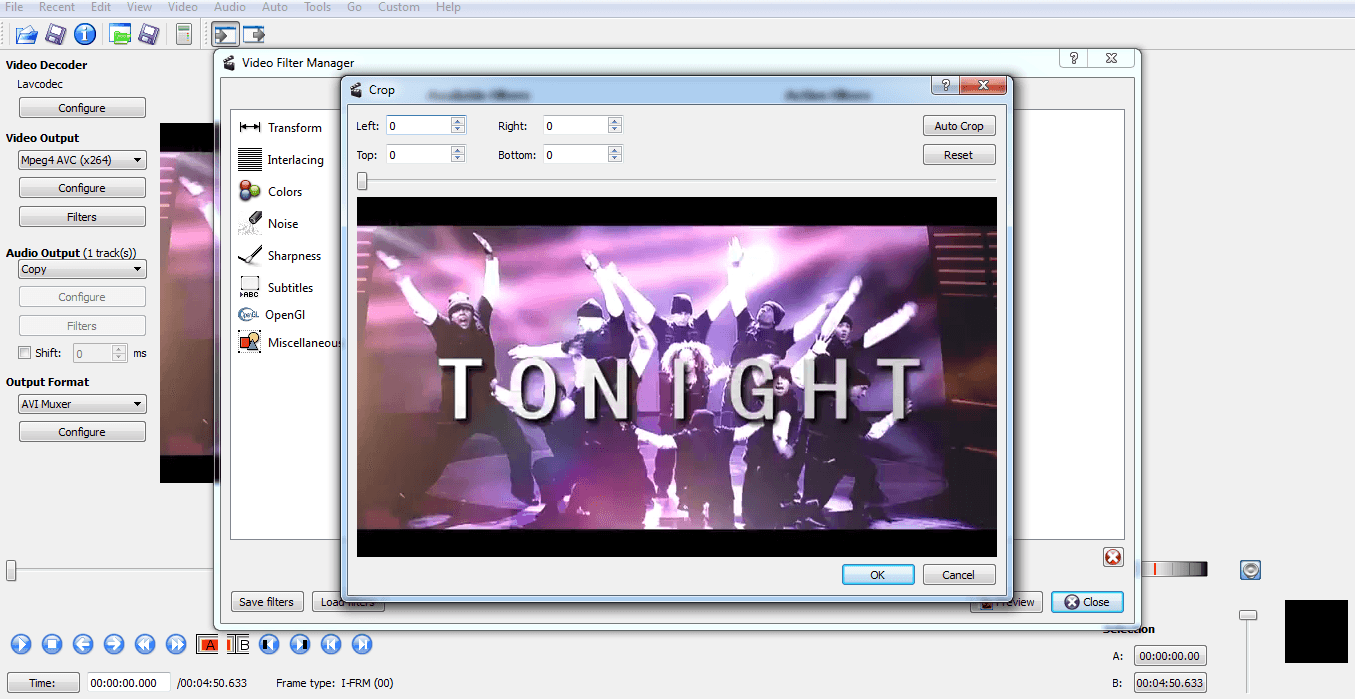
5. Cropping controls
There are two options for cropping, you can use the Auto crop feature, which will detect any black lines and crop the footage between them, or if you are using the crop tool for something else, or just want to do it manually, you can set the crop via the left right top and bottom boxes. Values input here are the number of pixels from that edge the crop extends, as you are setting it, this is displayed with a green block signifying the area of the image that will be removed.
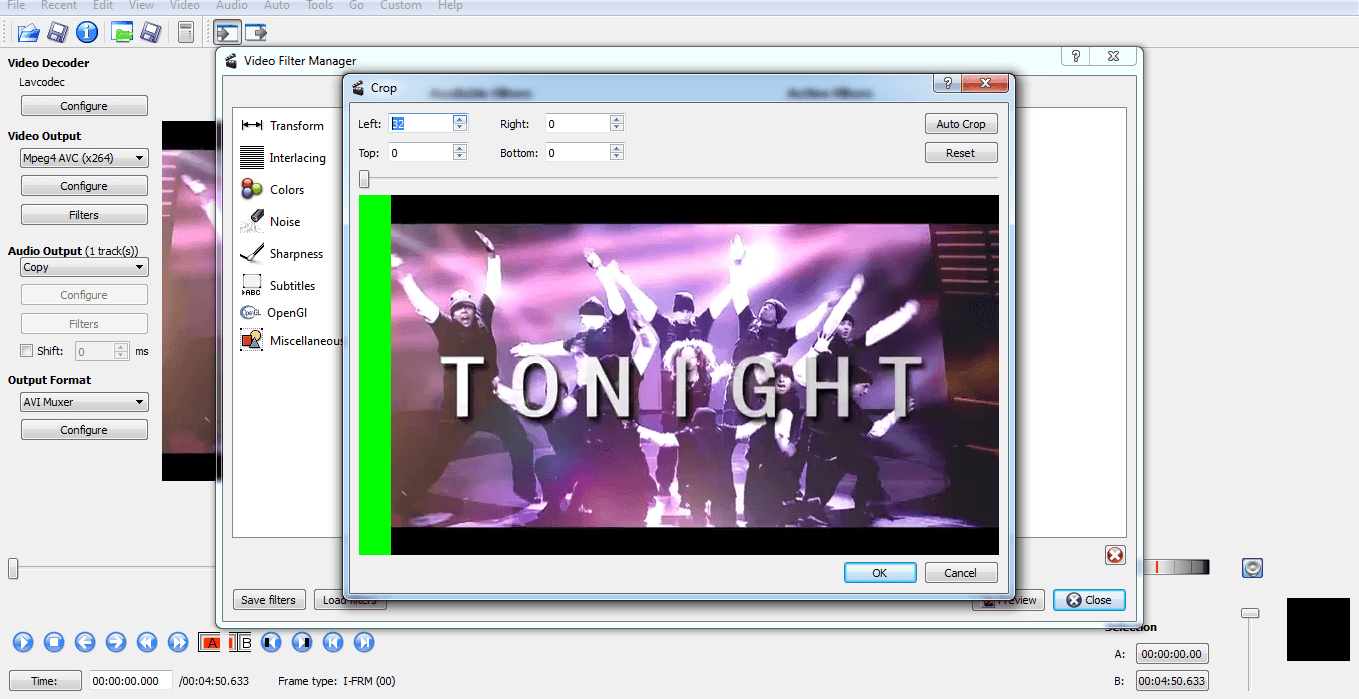
You can adjust this independently for all 4 edges as you wish.
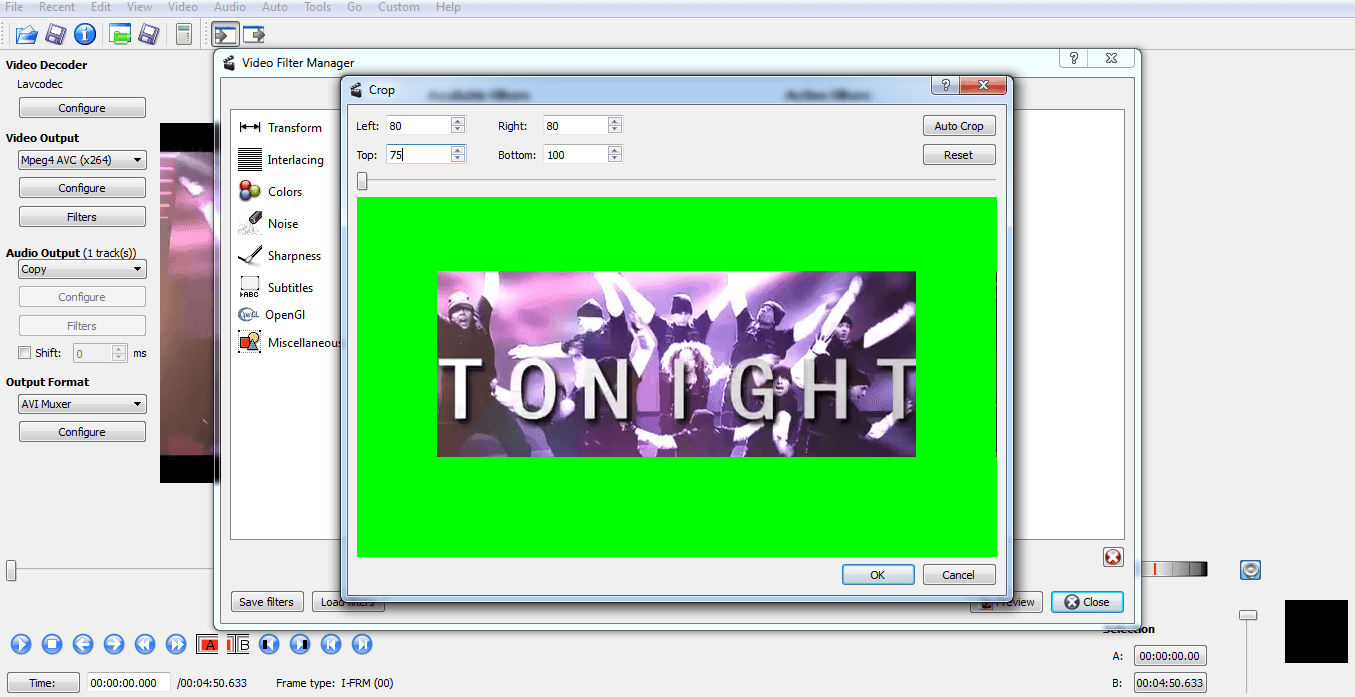
Once you are happy with the crop, you click Ok and it takes you back to the familiar filter menu where you can use other components to perform more editing if you need.
6. Saving the crop
One of the most common points of confusion with Avidemux comes at this point, as your video will look no different to when you started, and many think they have done something wrong, but this is another part of Avidemux workflow. These filters can only be applied when the video is reencoded, and you do that through the file>save menu.

Selecting this presents the familiar export dialogue and allows you to choose the name and destination of the file. Once that is done you click OK and you will see Avidemux processing your file and re-rendering it in this dialogue box.
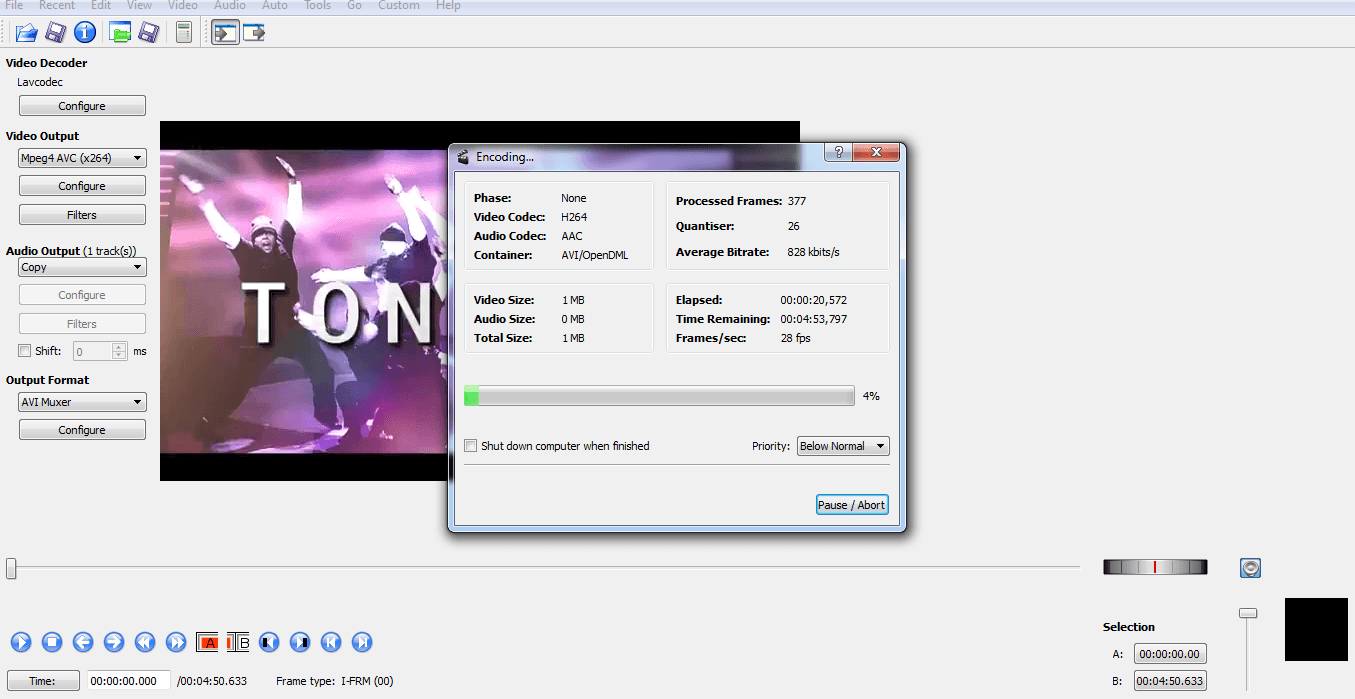
How long it takes will depend on a few factors, how many other effects have been added, how fast a processor your computer has, and how large and what resolution the video is. Format also plays a part in the process too, with some formats taking less time to encode than others. Once it has finished, you can view your video and see the crop in action.
As we can see, although there are a few aspects of the workflow that are a little unintuitive, cropping video in Avidemux is a straightforward process that anyone can accomplish with a bit of patience.
One of the key things to remember with Avidemux is that you apply all of your filters before re-encoding, this again is a question of patience and a bit of organization to ensure everything you wish to do is completed in order.
Avidemux is a great piece of software, it lacks the polish of some of its commercial rivals of course, but behind the sometimes clunky interface there is a very broad range of features that allow you to accomplish more or less any editing task you may want. In terms of free programs this is about as good as it gets, and the output is, without a doubt, great quality. For anyone looking for a free solution to video editing problems, and who do not mind a learning process Avidemux provides a useful tool.
An Easier Way to Crop a Video with Filmora
Filmora Video Editor is a powerful program that allows you to create stunning video clips in only a few clicks. This video editing software provides users with a variety of tools for editing videos. It also includes a user-friendly interface for editing home films on Windows PCs, Macs, and Linux devices. To crop a video, these are to follow:
Step 1: Open a video that you want to edit. Go to “Import” and choose the file that you want to upload and put it in the Media Library.
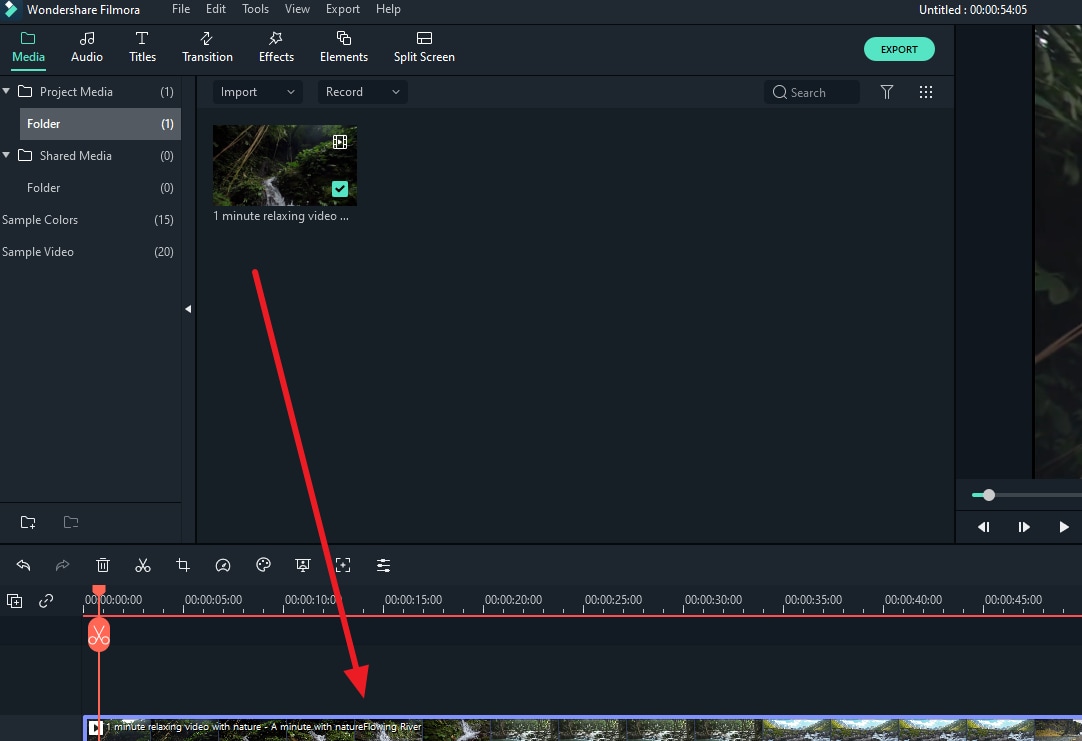
Step 2: Select the “Crop and Zoom” icon in the Filmora editing tool.
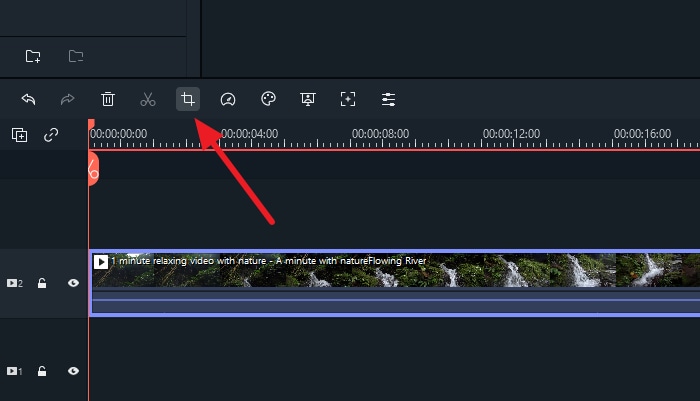
Step 3: To alter the size of the crop frame, drag the pointer from any corner of your video preview window.
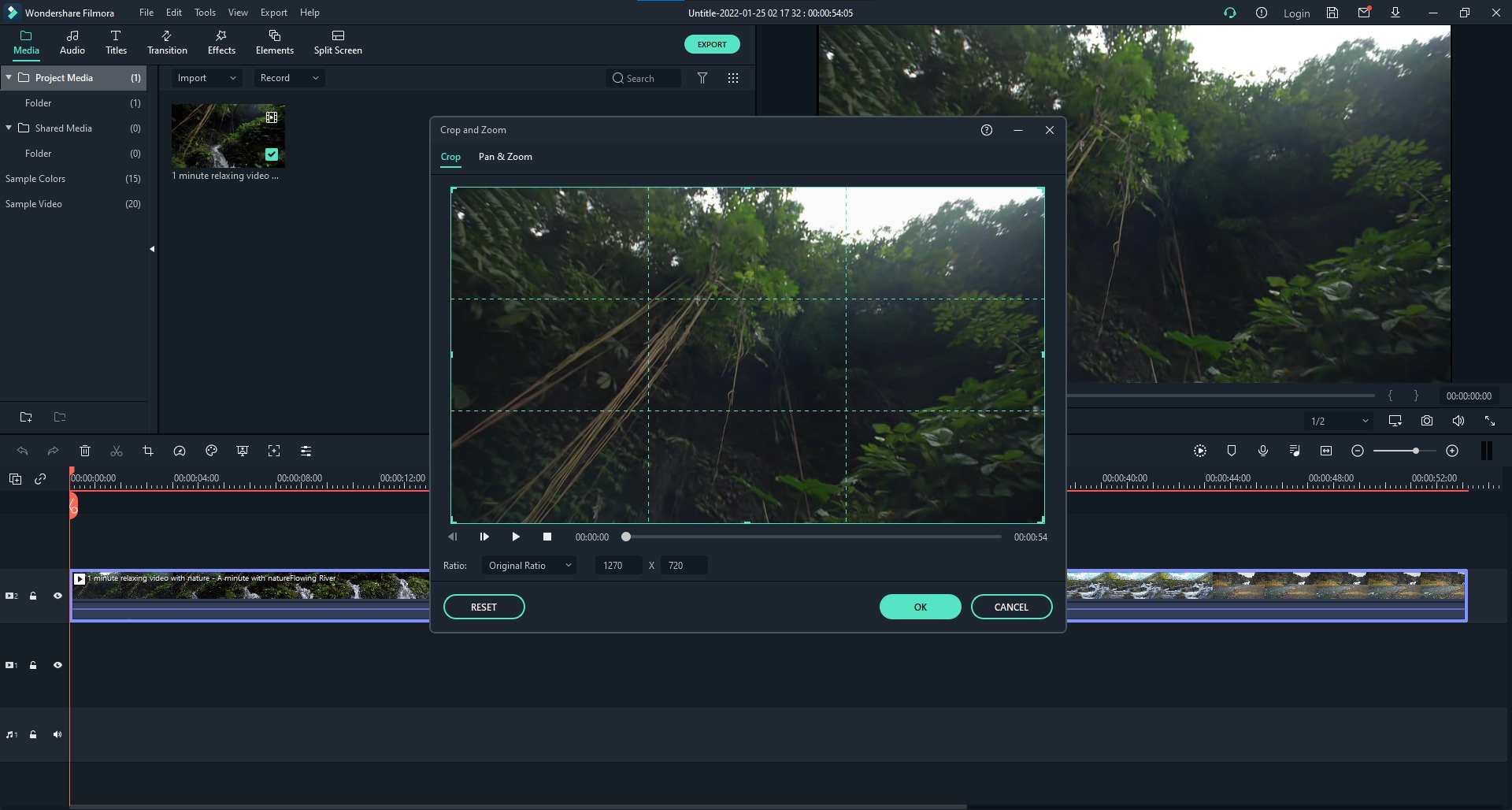
Step 4: When you’ve changed it to your liking, click the green “OK” button. As a result, you may effortlessly add or remove any element of a video clip on Filmora.


Ollie Mattison
Ollie Mattison is a writer and a lover of all things video.
Follow @Ollie Mattison
Ollie Mattison
Mar 27, 2024• Proven solutions
Cropping a video, to bring focus onto the important aspects and remove the extraneous parts of the scene, is one of the most valuable tools available to a video editor. It can be used as mentioned to ensure the viewer focuses on what is important, but also to magnify objects on the screen, such as with footage of nature. It has many uses, and one of the best tools available for cropping video is the free program Avidemux. Here we are going to go through the process of getting Avidemux running on your system and cropping some video.
If Avidemux is too complicate for you, you can consider Wondershare Filmora , which is an easy-to-use video editing tool to crop videos within several click. Download the free trial version blow.
 Download Mac Version ](https://tools.techidaily.com/wondershare/filmora/download/ )
Download Mac Version ](https://tools.techidaily.com/wondershare/filmora/download/ )
How to Crop a Video with Avidemux
1. Installation
You can find Avidemux for download here , it is available for a wide range of platforms, just download the version that fits your needs. Once downloaded, install in the standard way for your platform, this is the Wndows version (64bit).
One point of note during installation is that you can choose which parts of the program you wish to install. It is a very small footprint and for the best performance it is wise to simply install everything.

Once installed you will be presented with the program as seen here.

2. Importing Video
The next step is importing video. This can be done in two ways, by clicking the file folder icon at the top left you open a standard file browser to navigate to, and select your chosen video file, or alternatively you can simply drag you video into the main panel to import it.

Whichever route you take, you will end up with your video file loaded in like this.

Now you can edit the video as you need, Avidemux contains a wealth of features to enable the full spectrum of editing tasks to be completed. However, here we are going to look at the cropping tool, so on to the next step.
3. Editing Video
Avidemux has some idiosyncrasies in terms of operation, one of those is that to be able to edit any video, you have to choose your output format. Don’t worry though, this is easy, just use the dropdown at the side to choose the output format you want as can be seen here.

Once that is set you are free to start editing your footage.
4. Cropping
It is important to understand how the editing process works in Avidemux, everything is accessed via the filters menu Video>Filters and from here you are faced with a new interface that enables you to choose the component you wish to use.

Selecting ‘Crop’ from the menu and pressing the green plus symbol at the bottom activated the crop tool and presents you with yet another view that allows you to adjust the crop to your tastes.

5. Cropping controls
There are two options for cropping, you can use the Auto crop feature, which will detect any black lines and crop the footage between them, or if you are using the crop tool for something else, or just want to do it manually, you can set the crop via the left right top and bottom boxes. Values input here are the number of pixels from that edge the crop extends, as you are setting it, this is displayed with a green block signifying the area of the image that will be removed.

You can adjust this independently for all 4 edges as you wish.

Once you are happy with the crop, you click Ok and it takes you back to the familiar filter menu where you can use other components to perform more editing if you need.
6. Saving the crop
One of the most common points of confusion with Avidemux comes at this point, as your video will look no different to when you started, and many think they have done something wrong, but this is another part of Avidemux workflow. These filters can only be applied when the video is reencoded, and you do that through the file>save menu.

Selecting this presents the familiar export dialogue and allows you to choose the name and destination of the file. Once that is done you click OK and you will see Avidemux processing your file and re-rendering it in this dialogue box.

How long it takes will depend on a few factors, how many other effects have been added, how fast a processor your computer has, and how large and what resolution the video is. Format also plays a part in the process too, with some formats taking less time to encode than others. Once it has finished, you can view your video and see the crop in action.
As we can see, although there are a few aspects of the workflow that are a little unintuitive, cropping video in Avidemux is a straightforward process that anyone can accomplish with a bit of patience.
One of the key things to remember with Avidemux is that you apply all of your filters before re-encoding, this again is a question of patience and a bit of organization to ensure everything you wish to do is completed in order.
Avidemux is a great piece of software, it lacks the polish of some of its commercial rivals of course, but behind the sometimes clunky interface there is a very broad range of features that allow you to accomplish more or less any editing task you may want. In terms of free programs this is about as good as it gets, and the output is, without a doubt, great quality. For anyone looking for a free solution to video editing problems, and who do not mind a learning process Avidemux provides a useful tool.
An Easier Way to Crop a Video with Filmora
Filmora Video Editor is a powerful program that allows you to create stunning video clips in only a few clicks. This video editing software provides users with a variety of tools for editing videos. It also includes a user-friendly interface for editing home films on Windows PCs, Macs, and Linux devices. To crop a video, these are to follow:
Step 1: Open a video that you want to edit. Go to “Import” and choose the file that you want to upload and put it in the Media Library.

Step 2: Select the “Crop and Zoom” icon in the Filmora editing tool.

Step 3: To alter the size of the crop frame, drag the pointer from any corner of your video preview window.

Step 4: When you’ve changed it to your liking, click the green “OK” button. As a result, you may effortlessly add or remove any element of a video clip on Filmora.


Ollie Mattison
Ollie Mattison is a writer and a lover of all things video.
Follow @Ollie Mattison
Ollie Mattison
Mar 27, 2024• Proven solutions
Cropping a video, to bring focus onto the important aspects and remove the extraneous parts of the scene, is one of the most valuable tools available to a video editor. It can be used as mentioned to ensure the viewer focuses on what is important, but also to magnify objects on the screen, such as with footage of nature. It has many uses, and one of the best tools available for cropping video is the free program Avidemux. Here we are going to go through the process of getting Avidemux running on your system and cropping some video.
If Avidemux is too complicate for you, you can consider Wondershare Filmora , which is an easy-to-use video editing tool to crop videos within several click. Download the free trial version blow.
 Download Mac Version ](https://tools.techidaily.com/wondershare/filmora/download/ )
Download Mac Version ](https://tools.techidaily.com/wondershare/filmora/download/ )
How to Crop a Video with Avidemux
1. Installation
You can find Avidemux for download here , it is available for a wide range of platforms, just download the version that fits your needs. Once downloaded, install in the standard way for your platform, this is the Wndows version (64bit).
One point of note during installation is that you can choose which parts of the program you wish to install. It is a very small footprint and for the best performance it is wise to simply install everything.

Once installed you will be presented with the program as seen here.

2. Importing Video
The next step is importing video. This can be done in two ways, by clicking the file folder icon at the top left you open a standard file browser to navigate to, and select your chosen video file, or alternatively you can simply drag you video into the main panel to import it.

Whichever route you take, you will end up with your video file loaded in like this.

Now you can edit the video as you need, Avidemux contains a wealth of features to enable the full spectrum of editing tasks to be completed. However, here we are going to look at the cropping tool, so on to the next step.
3. Editing Video
Avidemux has some idiosyncrasies in terms of operation, one of those is that to be able to edit any video, you have to choose your output format. Don’t worry though, this is easy, just use the dropdown at the side to choose the output format you want as can be seen here.

Once that is set you are free to start editing your footage.
4. Cropping
It is important to understand how the editing process works in Avidemux, everything is accessed via the filters menu Video>Filters and from here you are faced with a new interface that enables you to choose the component you wish to use.

Selecting ‘Crop’ from the menu and pressing the green plus symbol at the bottom activated the crop tool and presents you with yet another view that allows you to adjust the crop to your tastes.

5. Cropping controls
There are two options for cropping, you can use the Auto crop feature, which will detect any black lines and crop the footage between them, or if you are using the crop tool for something else, or just want to do it manually, you can set the crop via the left right top and bottom boxes. Values input here are the number of pixels from that edge the crop extends, as you are setting it, this is displayed with a green block signifying the area of the image that will be removed.

You can adjust this independently for all 4 edges as you wish.

Once you are happy with the crop, you click Ok and it takes you back to the familiar filter menu where you can use other components to perform more editing if you need.
6. Saving the crop
One of the most common points of confusion with Avidemux comes at this point, as your video will look no different to when you started, and many think they have done something wrong, but this is another part of Avidemux workflow. These filters can only be applied when the video is reencoded, and you do that through the file>save menu.

Selecting this presents the familiar export dialogue and allows you to choose the name and destination of the file. Once that is done you click OK and you will see Avidemux processing your file and re-rendering it in this dialogue box.

How long it takes will depend on a few factors, how many other effects have been added, how fast a processor your computer has, and how large and what resolution the video is. Format also plays a part in the process too, with some formats taking less time to encode than others. Once it has finished, you can view your video and see the crop in action.
As we can see, although there are a few aspects of the workflow that are a little unintuitive, cropping video in Avidemux is a straightforward process that anyone can accomplish with a bit of patience.
One of the key things to remember with Avidemux is that you apply all of your filters before re-encoding, this again is a question of patience and a bit of organization to ensure everything you wish to do is completed in order.
Avidemux is a great piece of software, it lacks the polish of some of its commercial rivals of course, but behind the sometimes clunky interface there is a very broad range of features that allow you to accomplish more or less any editing task you may want. In terms of free programs this is about as good as it gets, and the output is, without a doubt, great quality. For anyone looking for a free solution to video editing problems, and who do not mind a learning process Avidemux provides a useful tool.
An Easier Way to Crop a Video with Filmora
Filmora Video Editor is a powerful program that allows you to create stunning video clips in only a few clicks. This video editing software provides users with a variety of tools for editing videos. It also includes a user-friendly interface for editing home films on Windows PCs, Macs, and Linux devices. To crop a video, these are to follow:
Step 1: Open a video that you want to edit. Go to “Import” and choose the file that you want to upload and put it in the Media Library.

Step 2: Select the “Crop and Zoom” icon in the Filmora editing tool.

Step 3: To alter the size of the crop frame, drag the pointer from any corner of your video preview window.

Step 4: When you’ve changed it to your liking, click the green “OK” button. As a result, you may effortlessly add or remove any element of a video clip on Filmora.


Ollie Mattison
Ollie Mattison is a writer and a lover of all things video.
Follow @Ollie Mattison
Ollie Mattison
Mar 27, 2024• Proven solutions
Cropping a video, to bring focus onto the important aspects and remove the extraneous parts of the scene, is one of the most valuable tools available to a video editor. It can be used as mentioned to ensure the viewer focuses on what is important, but also to magnify objects on the screen, such as with footage of nature. It has many uses, and one of the best tools available for cropping video is the free program Avidemux. Here we are going to go through the process of getting Avidemux running on your system and cropping some video.
If Avidemux is too complicate for you, you can consider Wondershare Filmora , which is an easy-to-use video editing tool to crop videos within several click. Download the free trial version blow.
 Download Mac Version ](https://tools.techidaily.com/wondershare/filmora/download/ )
Download Mac Version ](https://tools.techidaily.com/wondershare/filmora/download/ )
How to Crop a Video with Avidemux
1. Installation
You can find Avidemux for download here , it is available for a wide range of platforms, just download the version that fits your needs. Once downloaded, install in the standard way for your platform, this is the Wndows version (64bit).
One point of note during installation is that you can choose which parts of the program you wish to install. It is a very small footprint and for the best performance it is wise to simply install everything.

Once installed you will be presented with the program as seen here.

2. Importing Video
The next step is importing video. This can be done in two ways, by clicking the file folder icon at the top left you open a standard file browser to navigate to, and select your chosen video file, or alternatively you can simply drag you video into the main panel to import it.

Whichever route you take, you will end up with your video file loaded in like this.

Now you can edit the video as you need, Avidemux contains a wealth of features to enable the full spectrum of editing tasks to be completed. However, here we are going to look at the cropping tool, so on to the next step.
3. Editing Video
Avidemux has some idiosyncrasies in terms of operation, one of those is that to be able to edit any video, you have to choose your output format. Don’t worry though, this is easy, just use the dropdown at the side to choose the output format you want as can be seen here.

Once that is set you are free to start editing your footage.
4. Cropping
It is important to understand how the editing process works in Avidemux, everything is accessed via the filters menu Video>Filters and from here you are faced with a new interface that enables you to choose the component you wish to use.

Selecting ‘Crop’ from the menu and pressing the green plus symbol at the bottom activated the crop tool and presents you with yet another view that allows you to adjust the crop to your tastes.

5. Cropping controls
There are two options for cropping, you can use the Auto crop feature, which will detect any black lines and crop the footage between them, or if you are using the crop tool for something else, or just want to do it manually, you can set the crop via the left right top and bottom boxes. Values input here are the number of pixels from that edge the crop extends, as you are setting it, this is displayed with a green block signifying the area of the image that will be removed.

You can adjust this independently for all 4 edges as you wish.

Once you are happy with the crop, you click Ok and it takes you back to the familiar filter menu where you can use other components to perform more editing if you need.
6. Saving the crop
One of the most common points of confusion with Avidemux comes at this point, as your video will look no different to when you started, and many think they have done something wrong, but this is another part of Avidemux workflow. These filters can only be applied when the video is reencoded, and you do that through the file>save menu.

Selecting this presents the familiar export dialogue and allows you to choose the name and destination of the file. Once that is done you click OK and you will see Avidemux processing your file and re-rendering it in this dialogue box.

How long it takes will depend on a few factors, how many other effects have been added, how fast a processor your computer has, and how large and what resolution the video is. Format also plays a part in the process too, with some formats taking less time to encode than others. Once it has finished, you can view your video and see the crop in action.
As we can see, although there are a few aspects of the workflow that are a little unintuitive, cropping video in Avidemux is a straightforward process that anyone can accomplish with a bit of patience.
One of the key things to remember with Avidemux is that you apply all of your filters before re-encoding, this again is a question of patience and a bit of organization to ensure everything you wish to do is completed in order.
Avidemux is a great piece of software, it lacks the polish of some of its commercial rivals of course, but behind the sometimes clunky interface there is a very broad range of features that allow you to accomplish more or less any editing task you may want. In terms of free programs this is about as good as it gets, and the output is, without a doubt, great quality. For anyone looking for a free solution to video editing problems, and who do not mind a learning process Avidemux provides a useful tool.
An Easier Way to Crop a Video with Filmora
Filmora Video Editor is a powerful program that allows you to create stunning video clips in only a few clicks. This video editing software provides users with a variety of tools for editing videos. It also includes a user-friendly interface for editing home films on Windows PCs, Macs, and Linux devices. To crop a video, these are to follow:
Step 1: Open a video that you want to edit. Go to “Import” and choose the file that you want to upload and put it in the Media Library.

Step 2: Select the “Crop and Zoom” icon in the Filmora editing tool.

Step 3: To alter the size of the crop frame, drag the pointer from any corner of your video preview window.

Step 4: When you’ve changed it to your liking, click the green “OK” button. As a result, you may effortlessly add or remove any element of a video clip on Filmora.


Ollie Mattison
Ollie Mattison is a writer and a lover of all things video.
Follow @Ollie Mattison
Unbranded Video Merging: 7 Reliable Options to Try
Sometimes, when delving into the vast space of internet and trying to find the perfect online platforms or software in order to edit some videos, it might get frustrating to find only the ones with watermark. But of course, the resources are endless and in case we have some information, we can easily access the free video editing platforms which give us the opportunity to edit our videos without undesired logos on them. In this case, we will be discussing 6 video mergers without watermark, and the way we can use them – the tools and features they offer, and how we can get the best out of them.
- Photos by Microsoft
If you are too lazy to get high-quality results using popular video editors, like Filmora, try Photos App. It is a built-in program that usually opens your images on Windows 10, but you can also use it for merging your videos. And guess what? Since it comes within the system, all the features, although limited, are absolutely free.
How to Merge Videos on Windows using Photos App?
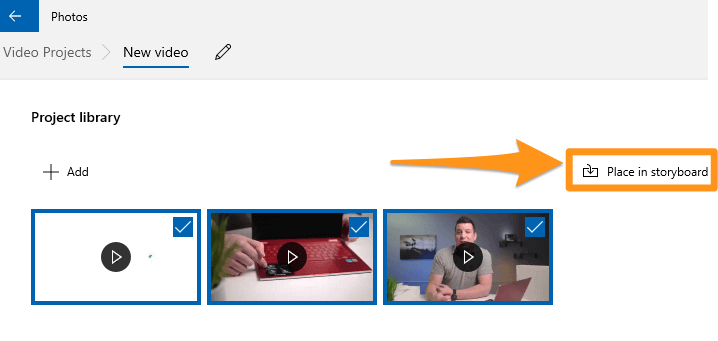
These are the steps to combine multiple clips in Windows 10 with Photos App.
Step 1: Open Photos App
Go to the ‘Start’ menu, find Photos App, and click to open it.
Step 2: Make a New Project
Click the ‘New video project’ (big blue box) under the ‘Video Projects’ tab. Alternatively, you can click the ‘New video’ button and select the ‘New video project’ option from the dropdown menu.
Step 3: Add Clips
Look for the text ‘Project library.’ Then click the ‘+ Add’ button. This will open a new window so you can select the clips you want to combine. Also, import videos one by one in a proper sequence because you cannot arrange them later.
Step 4: Make a Storyboard
After importing all the shots, you want to merge, click the ‘Place in storyboard’ button. This option will add all the chosen clips to your project’s storyboard.
- Fastreel by Movavi
Fastreel is a free online video editor. It is extremely easy to use right away, without installing anything. So, on Fastreel, one can edit videos or use online templates in the browser itself. Actually, the first tool we see in the list of Fastreel tools is to merge a video; then, it can be used in order to compress, make, cut, and create a video. On fastreel, you can add a watermark to a video, if wanted - so, it is very voluntary. As for the merging of a video, when this tool is chosen, it’s pretty simple to understand the steps – you can just drop/add multiple files right away.

The format must be either of the listed: MP4, MOV, MKV, AVI, and WMV, and the total size mustn’t exceed 500 MB. Then, in order to add some transitions, a style can be chosen from the drop-down menu, and after that, you should hit on Continue button to stitch the videos together. For the last step, you can export the result by selecting Download option.
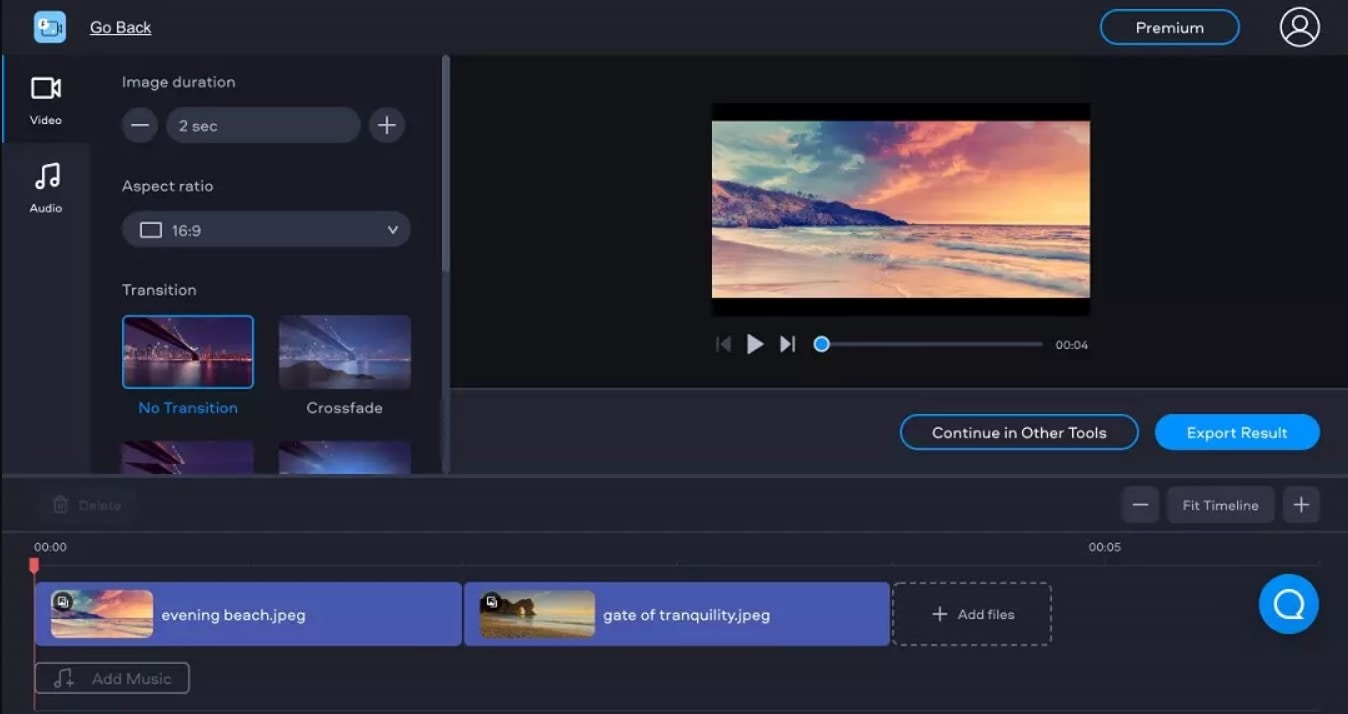
- Free Video Cutter Joiner
Free Video Cutter Joiner – the name already explains it all by itself! This is a free video merger which will not add watermark on your video. The software needs to be downloaded, and contributes to quickly cutting and joining videos. Free Video Cutter Joiner has no size limits – it can cut and merge videos with large file sizes without any trouble, and speed of it to do so is quite fast. It supports several file formats, such as AVI, MPEG, WMV, 3GP FLV, MP4, WMV, MOV, VOB, etc.
So, once downloaded, you will see how user-friendly and straightforward the software is: it shows two of its features right away – video cutter and video joiner. You choose which one you are about to use – so, in our case, video joiner.
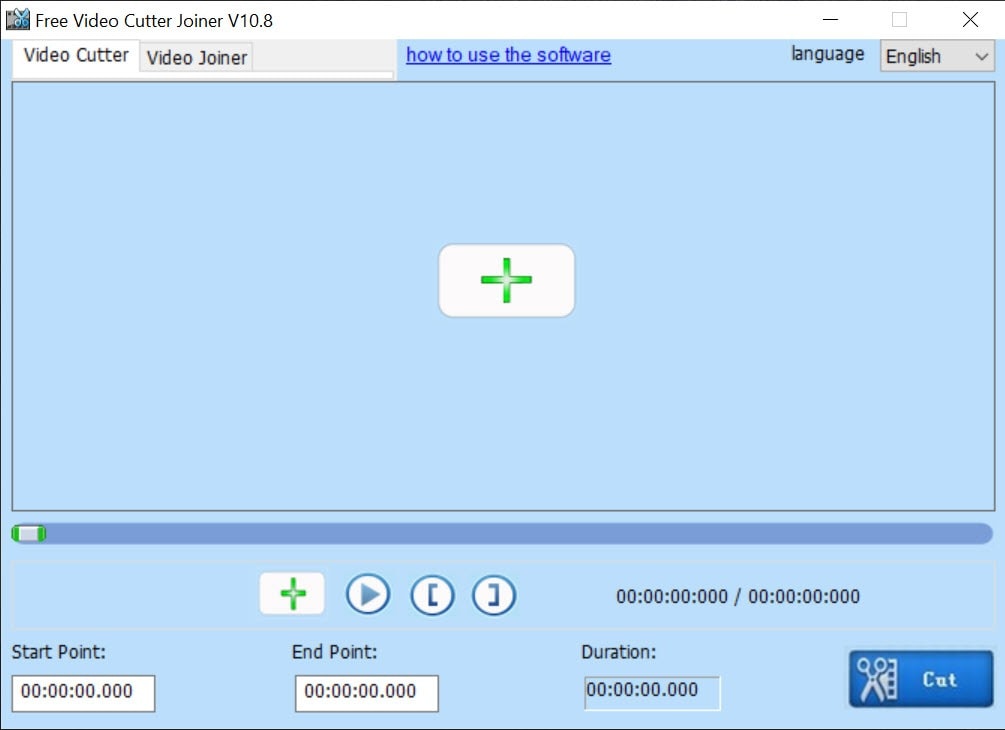
Then, you should click the the “+” icon, which lets you add files from your PC.

Then, hit on the Join button, and choose Indirect Join. Hitting on Start Join will start merging all the uploaded videos, and, wait a little until the process has been completed.
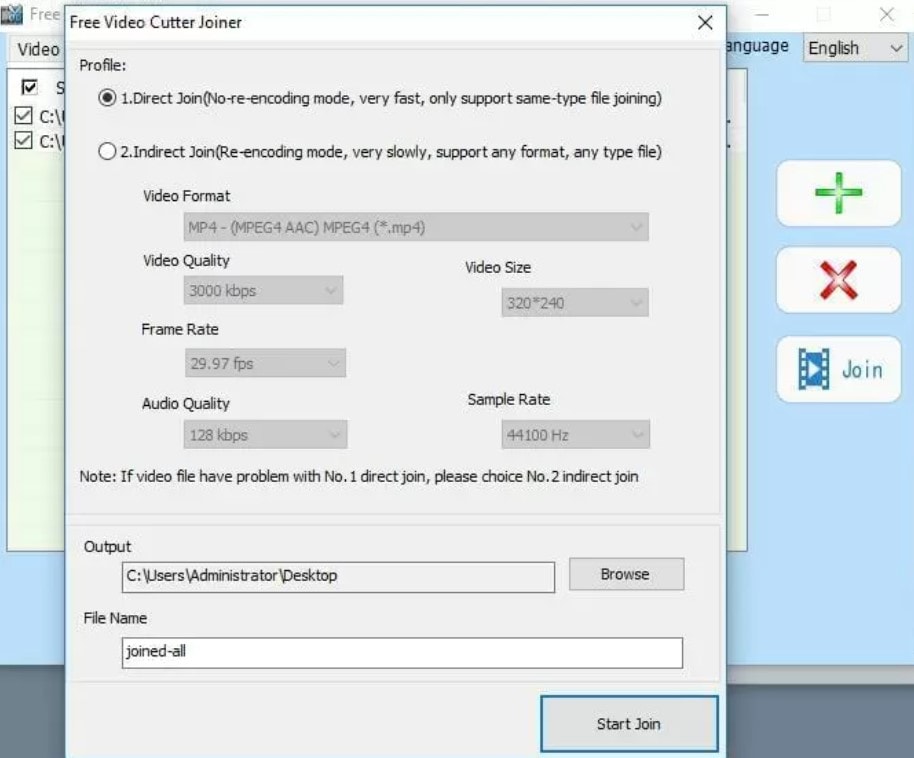
- Clideo
Clideo is the online platform that declares that it makes it super easy to edit all your video files, images and GIFs, and is totally free. It gives us the opportunities to: merge, compress, resize, cut, make, crop, speed, rotate, add music to, loop, flip, reverse, mute, filter, and adjust the videos. Add subtitles, make memes, create slideshows, etc. Therefore, it’s pretty rich in its tools and features.
As for merging videos, much like Fastreel, Clideo is pretty straightforward. You just click on the mentioned tool, and then easily choose files you would like to combine – you can merge any amount of video clips there. Several files can be chosen at the same time, or they can be added one by one.

Then it will take you to the editor, where you can join the videos. It’s possible to rearrange the files, by using drag-and-drop until they’re in the desired order. You can also add images and set duration from them, add audio, change its length and volume. The last step is choosing the aspect ratio and clicking the Export button. You can watch the preview of your result and then click on Download if you are satisfied with the merged file.

- Typito
Typito is a platform to merge videos online, as well as Fastreel and Clideo. It is free, and mostly aims to create combinations one can use to post on social network such as Instagram, Facebook, and Youtube. Typito supports a great many formats, some of them being MP4, AVI, FLV and WMV. You can edit your videos before merging them by trimming, cropping and resizing, and also add transition effects and music. It quickly combines footage, doesn’t watermark the videos, has brand kit of colors, fonts and style. It can also create collection of images, which is used for making Youtube compilation at most times.
To merge videos, you should choose the tool, then Get Started, and register and sign in first.

Then click on New Project, choose a video format (the platform offers you the list of the most popular ones), and it will take you to the editor, where you start off by adding media.

Drag and drop images or videos that you want to combine into a single video. You can also click to upload media files from your system or browse our Stock Media library for high-quality stock photos and video. Then, you can put your video clips in order, and work on it, if you want to use different tools, such as: edit, crop, trim, or resize them, as well as add text captions, images, and transitions. After you have previewed your video, you can click on the export button in the top right corner, and then, your merged video will be ready to be shared.
- Online UniConverter
Online UniConverter is the next online platform giving us the chance to merge our videos without watermark. It is an online analogue of Wondershare UniConverter, and is a very powerful platform, where you can trim, split, rotate, adjust, and download videos in HD quality. UniConverter supports numerous video formats, including MP4, AVI, MOV, MP3, WEBM. Online UniConverter offers various transitions and aspect ratios to fit the screen.
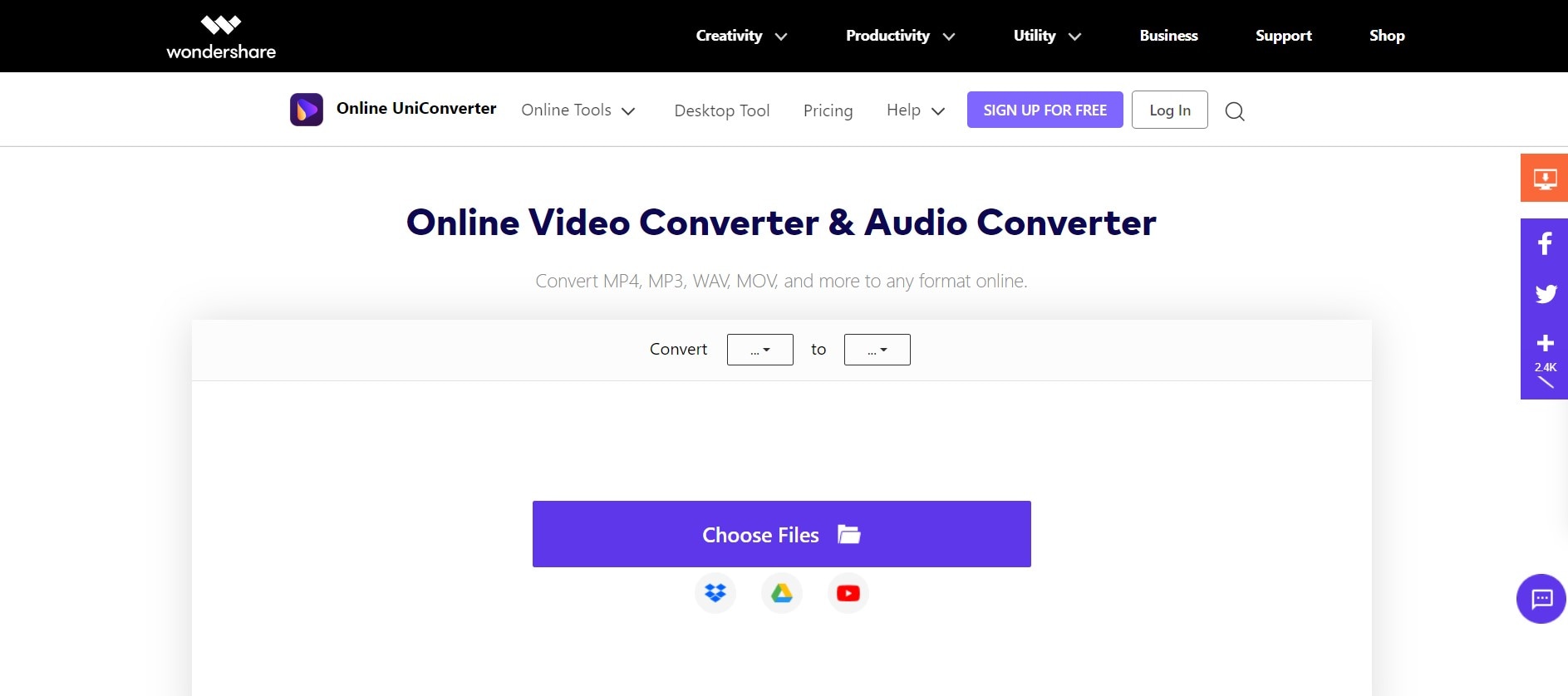
The web-site has lots of tools and features to offer: in the description of it, it reads: video converter, video compressor, video editor, audio converter, audio compressor, audio cutter, GIF maker, YouTube thumbnail, and image resizer. Importing media to the online UniConverter is extremely easy, and combining videos turns out to be a quick process, too.
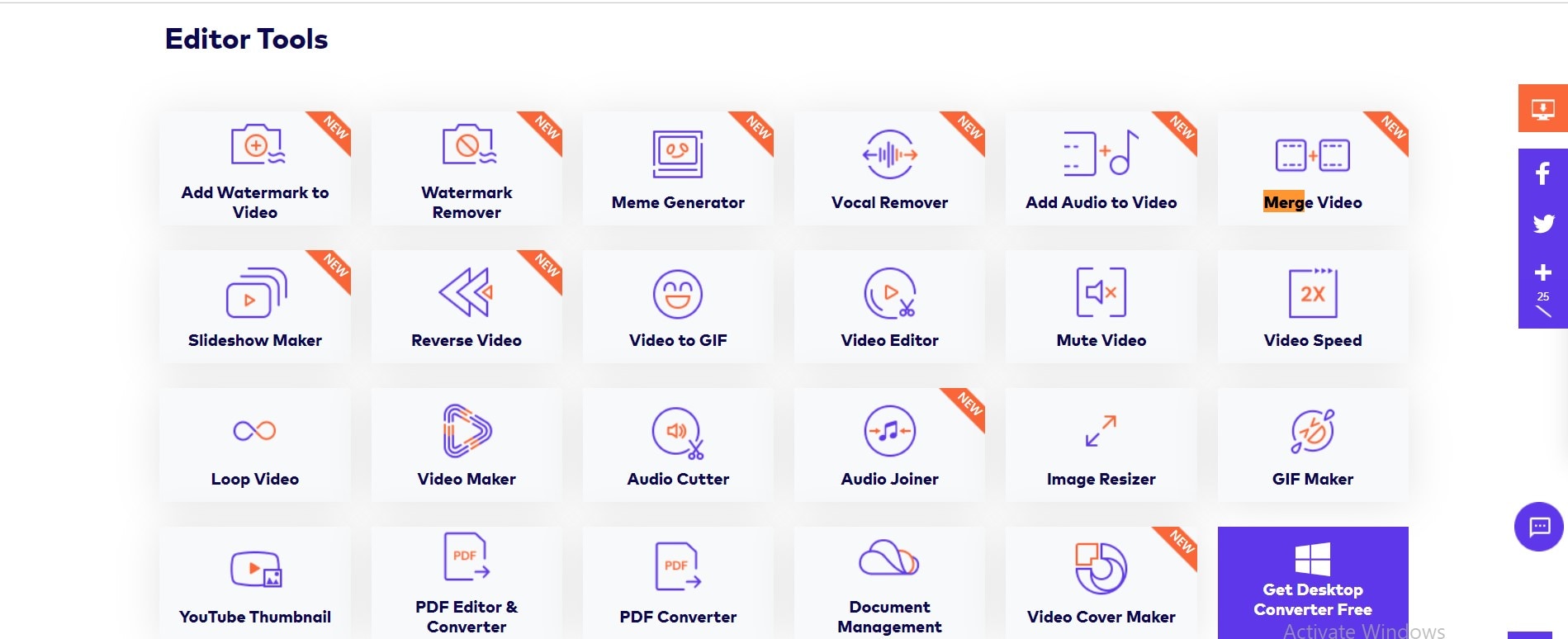
Anyway, if you want to combine a lot of files and the size of them all exceeds 100 MB, you will not be able to use Online Uniconverter for that. It supports the video no more than 100 MB and suggests using Wondershare UniConverter (originally Wondershare Video Converter Ultimate) for Desktop.
- Wondershare Filmora
Last but not least – Filmora Video Editor ! Even it differs from other abovementioned video mergers, as in it is not totally free and adds a Filmora logo on exported project, it’s a great suggestion for people who want to make their videos look great with the help of various tools. When a user is ready to pay, Filmora offers a subscription model, and for a bit more, one can get a permanent license. The software costs $51.99 per year or $79.99 for an outright purchase (prices are regularly discounted).
Wondershare Filmora has a clear and pleasing interface, offers trimming, transitions, overlays, several effects, as well as some more advanced and modern features, such as motion tracking. For this one particular software, we will be offering a step by step guide about how to merge videos there.
For Win 7 or later (64-bit)
For macOS 10.14 or later
- Open the program.
- Choose Import Media Files Here.

- Choose your
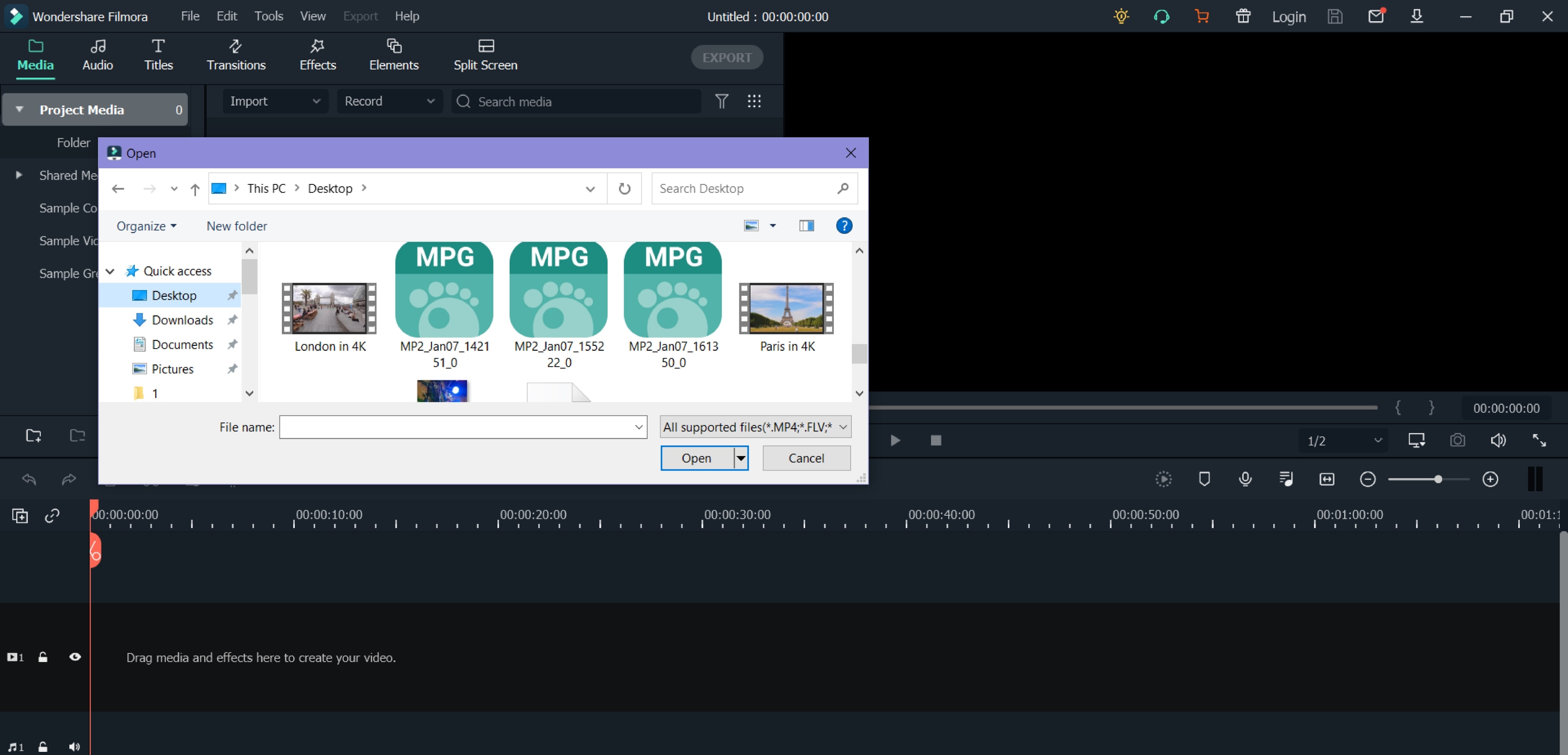
- We can click and drag, essentially, “insert” a video in a sequence below. The Linear Timeline allows us to understand exactly when a video clip ends and when a new one starts.

- Accordingly, we can make one video “sit” next to another. If we want or need it, we will add the third video clip, fourth, and so on.
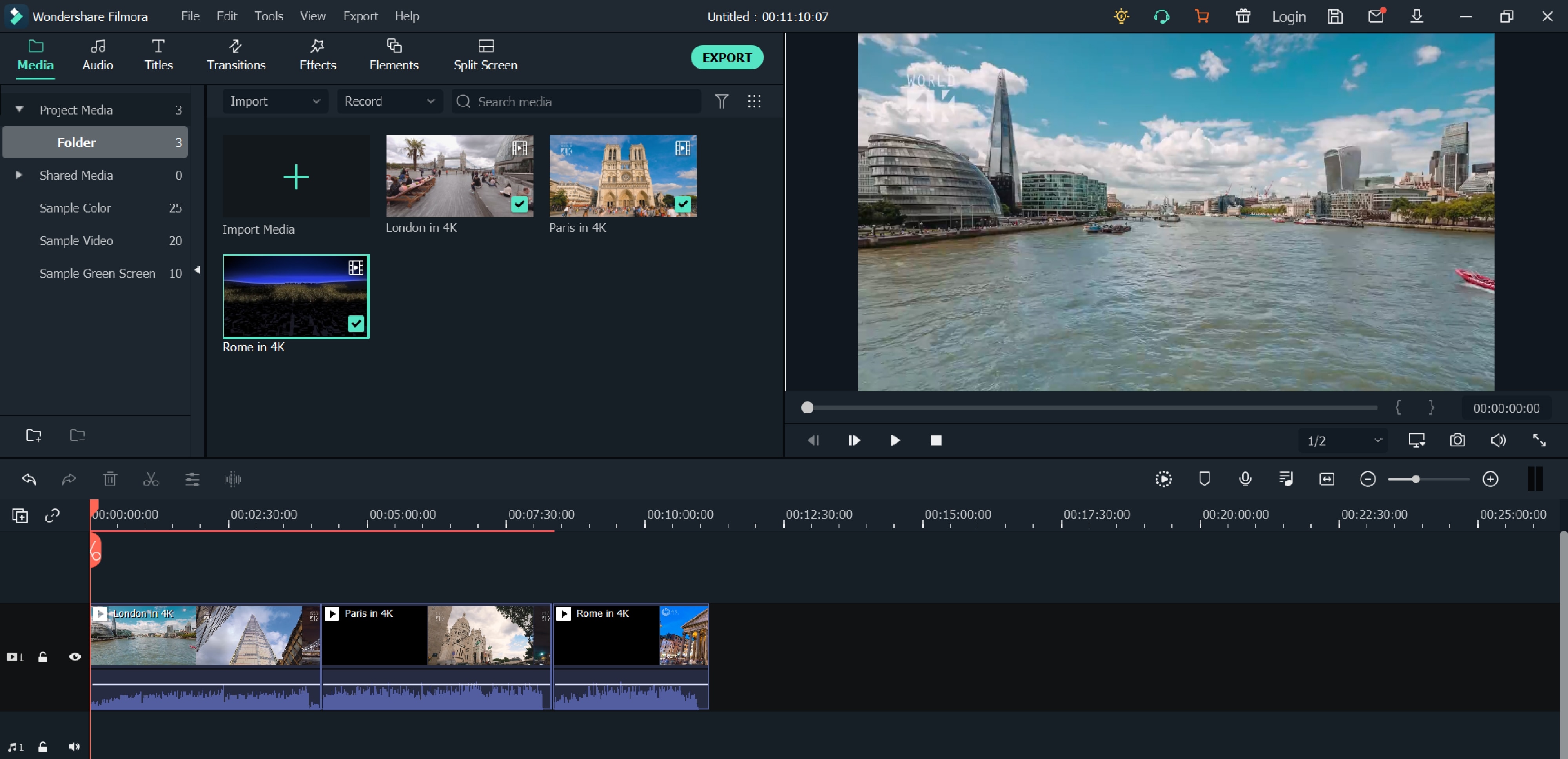
- We can view the entire video and save the video afterwards.
- Start to save video - we make sure the result is exactly what we wanted, find the Export button above the timeline and click on it.
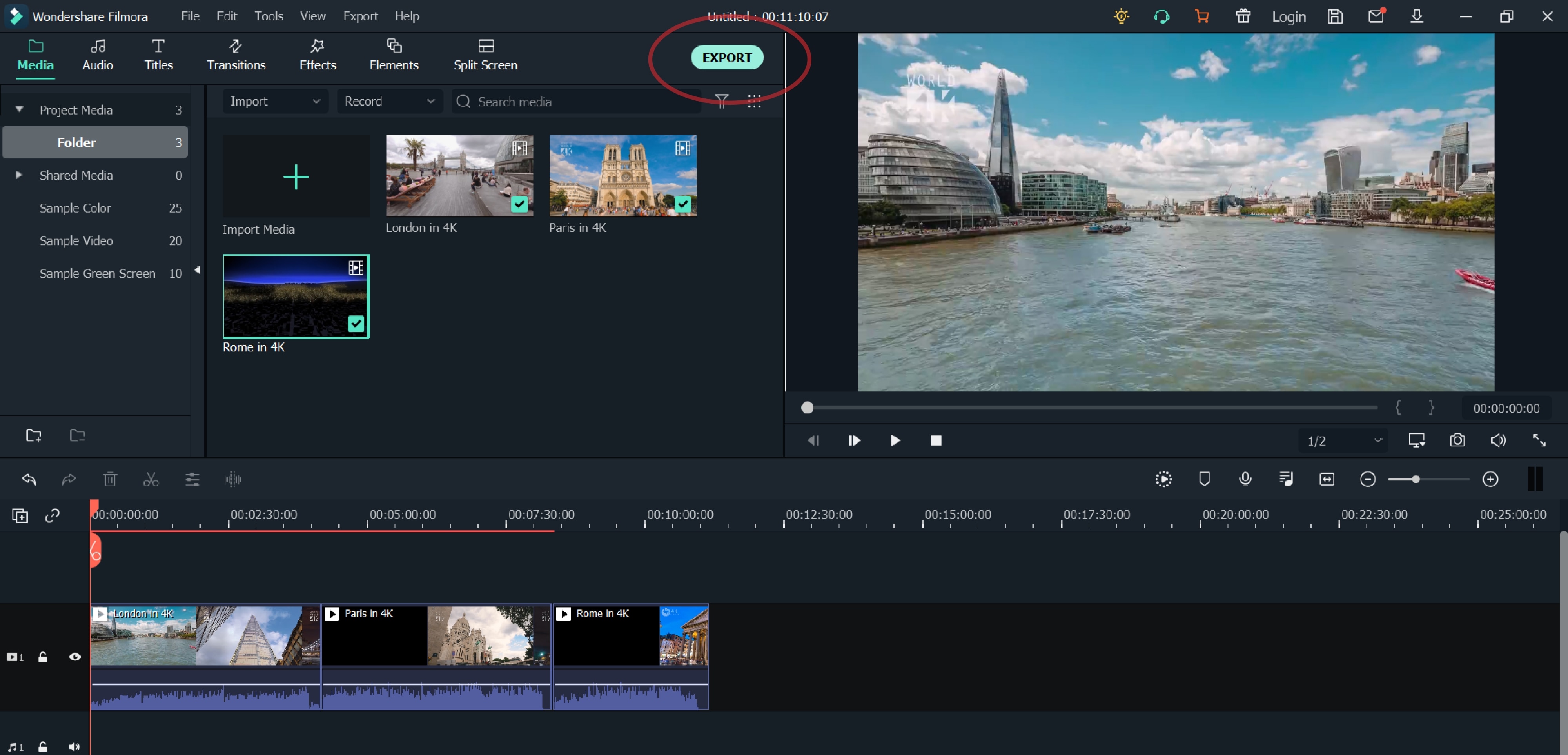
- In the opened window, on the left side, to be precise, if we observe well, we can already choose in which format we want to save our clip. On the right we can indicate what name we want to give to our video; The location where we want to store it; Also, we see the resolution (which we can modify freely after clicking on Settings); Size; Duration.
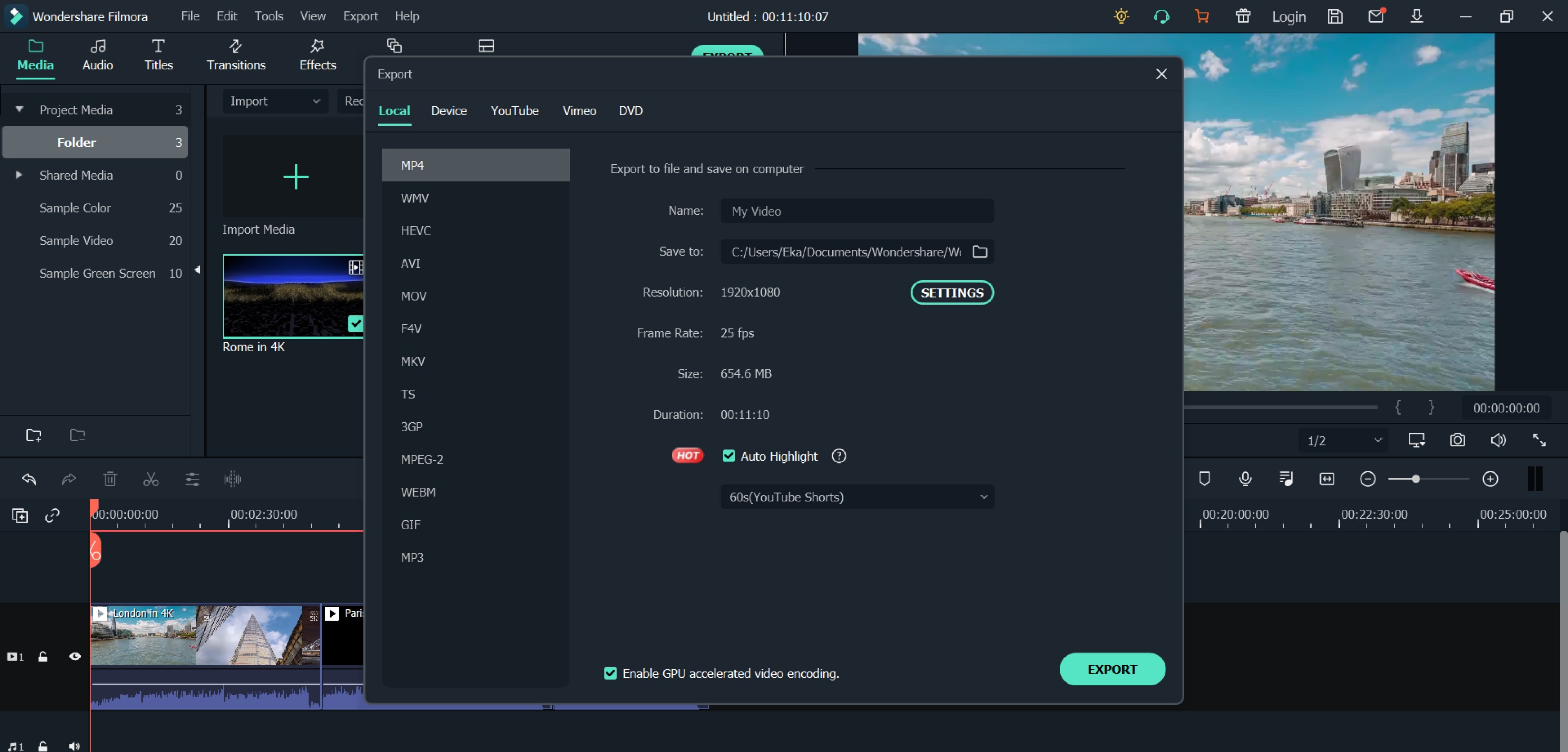
- In Settings, we can decide how much quality the video should have, how many kbps will be the Bit Rate, how many fps the Frame Rate should be, etc., but most likely, beginners will not need to change all this.
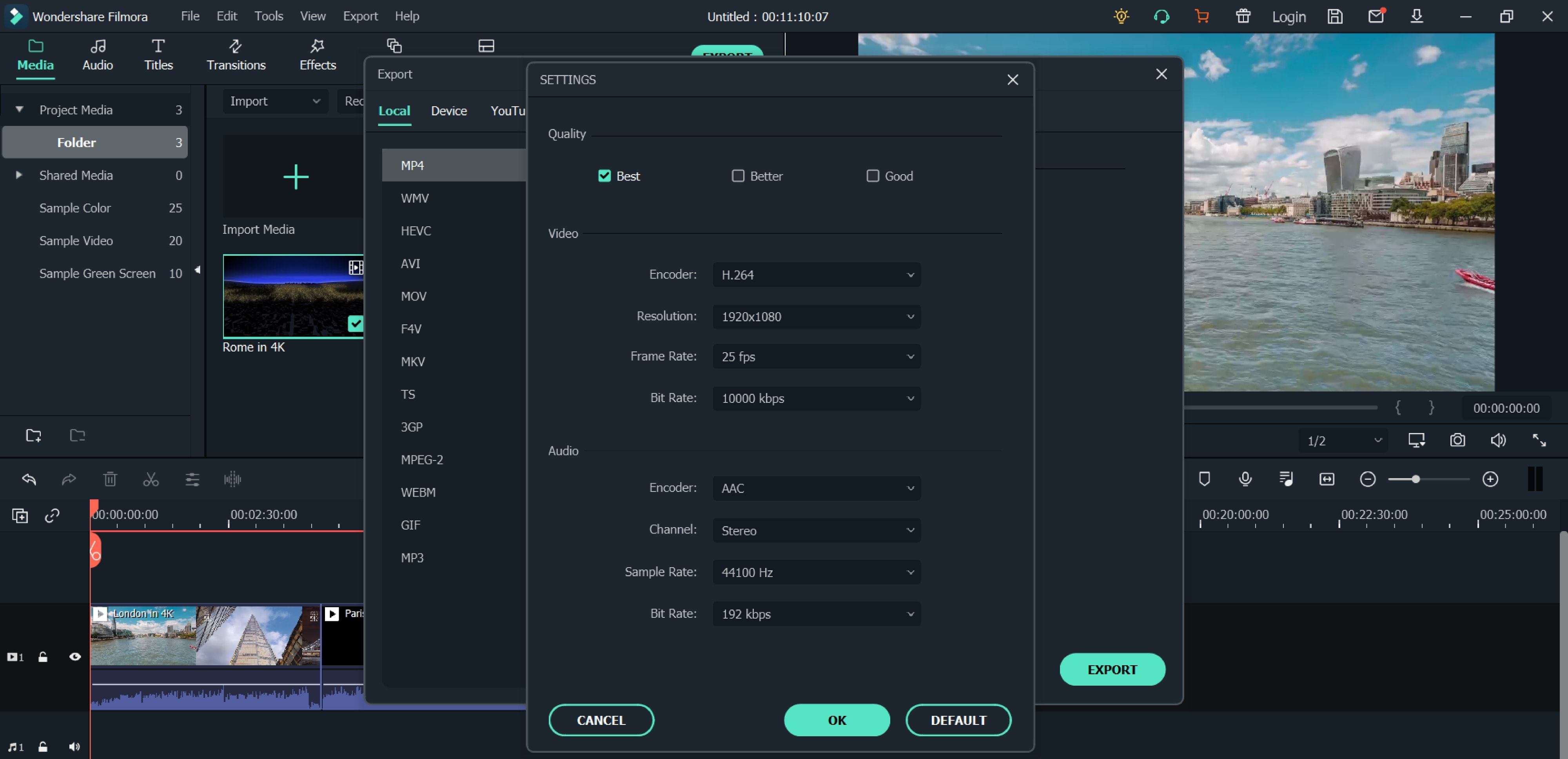
- After selecting everything, right-click on the Export button in the lower right corner of the window and the program will start saving the material.
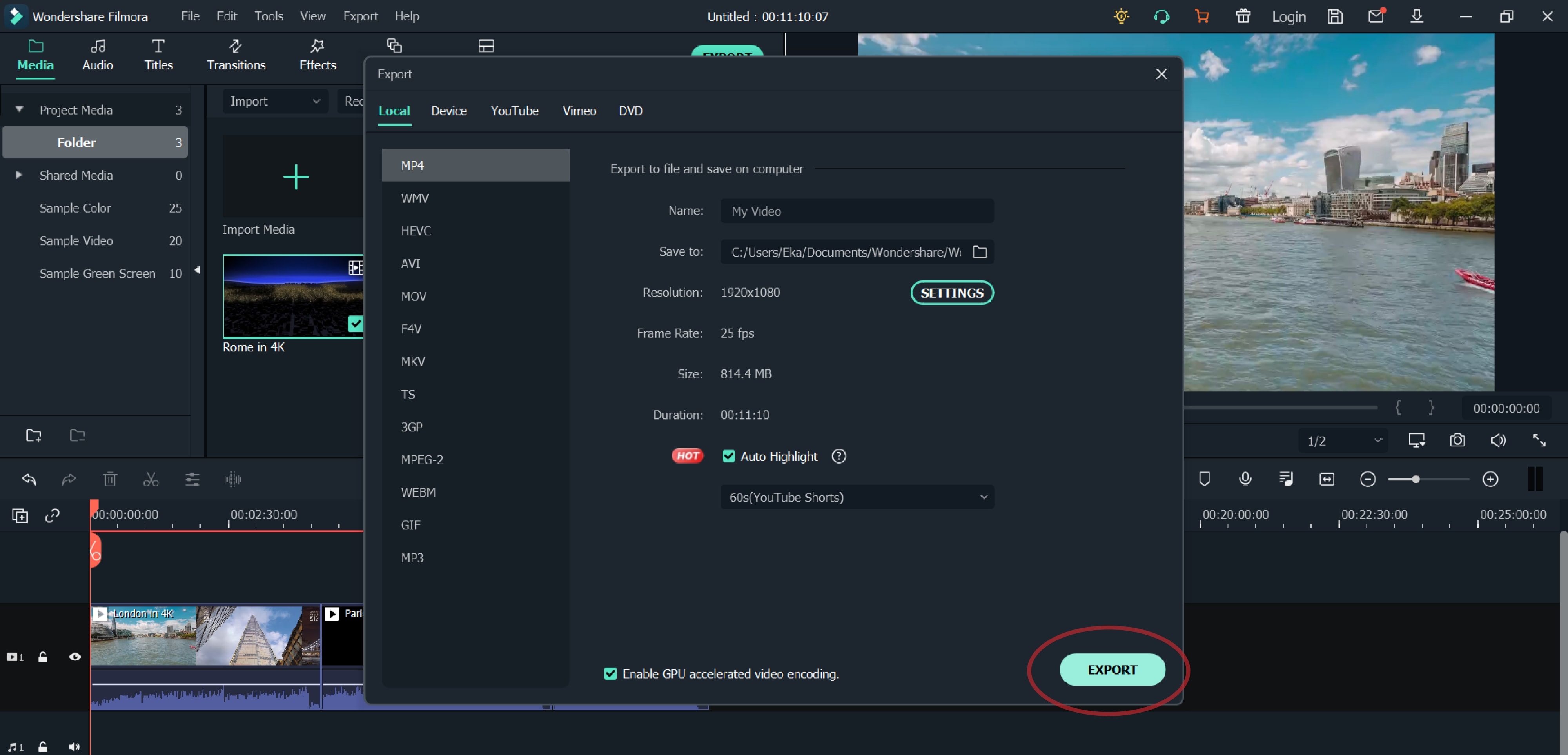

So, in this article, we introduced some online platforms and software for you to use if you would like to merge videos and combine them into one. These are: Fastreel, Free Video Cutter Joiner, Clideo, Typito, Online UniConverter, Wondershare Filmora. It’s up to you which one you would like to choose to merge your videos or edit them in any other way, but you can try either of them and choose to your own liking – even so, of course, there are some other video mergers worth considering, that we might mention in the coming articles. Before then, enjoy with free video editors, without watermark!
If you are too lazy to get high-quality results using popular video editors, like Filmora, try Photos App. It is a built-in program that usually opens your images on Windows 10, but you can also use it for merging your videos. And guess what? Since it comes within the system, all the features, although limited, are absolutely free.
How to Merge Videos on Windows using Photos App?

These are the steps to combine multiple clips in Windows 10 with Photos App.
Step 1: Open Photos App
Go to the ‘Start’ menu, find Photos App, and click to open it.
Step 2: Make a New Project
Click the ‘New video project’ (big blue box) under the ‘Video Projects’ tab. Alternatively, you can click the ‘New video’ button and select the ‘New video project’ option from the dropdown menu.
Step 3: Add Clips
Look for the text ‘Project library.’ Then click the ‘+ Add’ button. This will open a new window so you can select the clips you want to combine. Also, import videos one by one in a proper sequence because you cannot arrange them later.
Step 4: Make a Storyboard
After importing all the shots, you want to merge, click the ‘Place in storyboard’ button. This option will add all the chosen clips to your project’s storyboard.
- Fastreel by Movavi
Fastreel is a free online video editor. It is extremely easy to use right away, without installing anything. So, on Fastreel, one can edit videos or use online templates in the browser itself. Actually, the first tool we see in the list of Fastreel tools is to merge a video; then, it can be used in order to compress, make, cut, and create a video. On fastreel, you can add a watermark to a video, if wanted - so, it is very voluntary. As for the merging of a video, when this tool is chosen, it’s pretty simple to understand the steps – you can just drop/add multiple files right away.

The format must be either of the listed: MP4, MOV, MKV, AVI, and WMV, and the total size mustn’t exceed 500 MB. Then, in order to add some transitions, a style can be chosen from the drop-down menu, and after that, you should hit on Continue button to stitch the videos together. For the last step, you can export the result by selecting Download option.

- Free Video Cutter Joiner
Free Video Cutter Joiner – the name already explains it all by itself! This is a free video merger which will not add watermark on your video. The software needs to be downloaded, and contributes to quickly cutting and joining videos. Free Video Cutter Joiner has no size limits – it can cut and merge videos with large file sizes without any trouble, and speed of it to do so is quite fast. It supports several file formats, such as AVI, MPEG, WMV, 3GP FLV, MP4, WMV, MOV, VOB, etc.
So, once downloaded, you will see how user-friendly and straightforward the software is: it shows two of its features right away – video cutter and video joiner. You choose which one you are about to use – so, in our case, video joiner.

Then, you should click the the “+” icon, which lets you add files from your PC.

Then, hit on the Join button, and choose Indirect Join. Hitting on Start Join will start merging all the uploaded videos, and, wait a little until the process has been completed.

- Clideo
Clideo is the online platform that declares that it makes it super easy to edit all your video files, images and GIFs, and is totally free. It gives us the opportunities to: merge, compress, resize, cut, make, crop, speed, rotate, add music to, loop, flip, reverse, mute, filter, and adjust the videos. Add subtitles, make memes, create slideshows, etc. Therefore, it’s pretty rich in its tools and features.
As for merging videos, much like Fastreel, Clideo is pretty straightforward. You just click on the mentioned tool, and then easily choose files you would like to combine – you can merge any amount of video clips there. Several files can be chosen at the same time, or they can be added one by one.

Then it will take you to the editor, where you can join the videos. It’s possible to rearrange the files, by using drag-and-drop until they’re in the desired order. You can also add images and set duration from them, add audio, change its length and volume. The last step is choosing the aspect ratio and clicking the Export button. You can watch the preview of your result and then click on Download if you are satisfied with the merged file.

- Typito
Typito is a platform to merge videos online, as well as Fastreel and Clideo. It is free, and mostly aims to create combinations one can use to post on social network such as Instagram, Facebook, and Youtube. Typito supports a great many formats, some of them being MP4, AVI, FLV and WMV. You can edit your videos before merging them by trimming, cropping and resizing, and also add transition effects and music. It quickly combines footage, doesn’t watermark the videos, has brand kit of colors, fonts and style. It can also create collection of images, which is used for making Youtube compilation at most times.
To merge videos, you should choose the tool, then Get Started, and register and sign in first.

Then click on New Project, choose a video format (the platform offers you the list of the most popular ones), and it will take you to the editor, where you start off by adding media.

Drag and drop images or videos that you want to combine into a single video. You can also click to upload media files from your system or browse our Stock Media library for high-quality stock photos and video. Then, you can put your video clips in order, and work on it, if you want to use different tools, such as: edit, crop, trim, or resize them, as well as add text captions, images, and transitions. After you have previewed your video, you can click on the export button in the top right corner, and then, your merged video will be ready to be shared.
- Online UniConverter
Online UniConverter is the next online platform giving us the chance to merge our videos without watermark. It is an online analogue of Wondershare UniConverter, and is a very powerful platform, where you can trim, split, rotate, adjust, and download videos in HD quality. UniConverter supports numerous video formats, including MP4, AVI, MOV, MP3, WEBM. Online UniConverter offers various transitions and aspect ratios to fit the screen.

The web-site has lots of tools and features to offer: in the description of it, it reads: video converter, video compressor, video editor, audio converter, audio compressor, audio cutter, GIF maker, YouTube thumbnail, and image resizer. Importing media to the online UniConverter is extremely easy, and combining videos turns out to be a quick process, too.

Anyway, if you want to combine a lot of files and the size of them all exceeds 100 MB, you will not be able to use Online Uniconverter for that. It supports the video no more than 100 MB and suggests using Wondershare UniConverter (originally Wondershare Video Converter Ultimate) for Desktop.
- Wondershare Filmora
Last but not least – Filmora Video Editor ! Even it differs from other abovementioned video mergers, as in it is not totally free and adds a Filmora logo on exported project, it’s a great suggestion for people who want to make their videos look great with the help of various tools. When a user is ready to pay, Filmora offers a subscription model, and for a bit more, one can get a permanent license. The software costs $51.99 per year or $79.99 for an outright purchase (prices are regularly discounted).
Wondershare Filmora has a clear and pleasing interface, offers trimming, transitions, overlays, several effects, as well as some more advanced and modern features, such as motion tracking. For this one particular software, we will be offering a step by step guide about how to merge videos there.
For Win 7 or later (64-bit)
For macOS 10.14 or later
- Open the program.
- Choose Import Media Files Here.

- Choose your

- We can click and drag, essentially, “insert” a video in a sequence below. The Linear Timeline allows us to understand exactly when a video clip ends and when a new one starts.

- Accordingly, we can make one video “sit” next to another. If we want or need it, we will add the third video clip, fourth, and so on.

- We can view the entire video and save the video afterwards.
- Start to save video - we make sure the result is exactly what we wanted, find the Export button above the timeline and click on it.

- In the opened window, on the left side, to be precise, if we observe well, we can already choose in which format we want to save our clip. On the right we can indicate what name we want to give to our video; The location where we want to store it; Also, we see the resolution (which we can modify freely after clicking on Settings); Size; Duration.

- In Settings, we can decide how much quality the video should have, how many kbps will be the Bit Rate, how many fps the Frame Rate should be, etc., but most likely, beginners will not need to change all this.

- After selecting everything, right-click on the Export button in the lower right corner of the window and the program will start saving the material.


So, in this article, we introduced some online platforms and software for you to use if you would like to merge videos and combine them into one. These are: Fastreel, Free Video Cutter Joiner, Clideo, Typito, Online UniConverter, Wondershare Filmora. It’s up to you which one you would like to choose to merge your videos or edit them in any other way, but you can try either of them and choose to your own liking – even so, of course, there are some other video mergers worth considering, that we might mention in the coming articles. Before then, enjoy with free video editors, without watermark!
If you are too lazy to get high-quality results using popular video editors, like Filmora, try Photos App. It is a built-in program that usually opens your images on Windows 10, but you can also use it for merging your videos. And guess what? Since it comes within the system, all the features, although limited, are absolutely free.
How to Merge Videos on Windows using Photos App?

These are the steps to combine multiple clips in Windows 10 with Photos App.
Step 1: Open Photos App
Go to the ‘Start’ menu, find Photos App, and click to open it.
Step 2: Make a New Project
Click the ‘New video project’ (big blue box) under the ‘Video Projects’ tab. Alternatively, you can click the ‘New video’ button and select the ‘New video project’ option from the dropdown menu.
Step 3: Add Clips
Look for the text ‘Project library.’ Then click the ‘+ Add’ button. This will open a new window so you can select the clips you want to combine. Also, import videos one by one in a proper sequence because you cannot arrange them later.
Step 4: Make a Storyboard
After importing all the shots, you want to merge, click the ‘Place in storyboard’ button. This option will add all the chosen clips to your project’s storyboard.
- Fastreel by Movavi
Fastreel is a free online video editor. It is extremely easy to use right away, without installing anything. So, on Fastreel, one can edit videos or use online templates in the browser itself. Actually, the first tool we see in the list of Fastreel tools is to merge a video; then, it can be used in order to compress, make, cut, and create a video. On fastreel, you can add a watermark to a video, if wanted - so, it is very voluntary. As for the merging of a video, when this tool is chosen, it’s pretty simple to understand the steps – you can just drop/add multiple files right away.

The format must be either of the listed: MP4, MOV, MKV, AVI, and WMV, and the total size mustn’t exceed 500 MB. Then, in order to add some transitions, a style can be chosen from the drop-down menu, and after that, you should hit on Continue button to stitch the videos together. For the last step, you can export the result by selecting Download option.

- Free Video Cutter Joiner
Free Video Cutter Joiner – the name already explains it all by itself! This is a free video merger which will not add watermark on your video. The software needs to be downloaded, and contributes to quickly cutting and joining videos. Free Video Cutter Joiner has no size limits – it can cut and merge videos with large file sizes without any trouble, and speed of it to do so is quite fast. It supports several file formats, such as AVI, MPEG, WMV, 3GP FLV, MP4, WMV, MOV, VOB, etc.
So, once downloaded, you will see how user-friendly and straightforward the software is: it shows two of its features right away – video cutter and video joiner. You choose which one you are about to use – so, in our case, video joiner.

Then, you should click the the “+” icon, which lets you add files from your PC.

Then, hit on the Join button, and choose Indirect Join. Hitting on Start Join will start merging all the uploaded videos, and, wait a little until the process has been completed.

- Clideo
Clideo is the online platform that declares that it makes it super easy to edit all your video files, images and GIFs, and is totally free. It gives us the opportunities to: merge, compress, resize, cut, make, crop, speed, rotate, add music to, loop, flip, reverse, mute, filter, and adjust the videos. Add subtitles, make memes, create slideshows, etc. Therefore, it’s pretty rich in its tools and features.
As for merging videos, much like Fastreel, Clideo is pretty straightforward. You just click on the mentioned tool, and then easily choose files you would like to combine – you can merge any amount of video clips there. Several files can be chosen at the same time, or they can be added one by one.

Then it will take you to the editor, where you can join the videos. It’s possible to rearrange the files, by using drag-and-drop until they’re in the desired order. You can also add images and set duration from them, add audio, change its length and volume. The last step is choosing the aspect ratio and clicking the Export button. You can watch the preview of your result and then click on Download if you are satisfied with the merged file.

- Typito
Typito is a platform to merge videos online, as well as Fastreel and Clideo. It is free, and mostly aims to create combinations one can use to post on social network such as Instagram, Facebook, and Youtube. Typito supports a great many formats, some of them being MP4, AVI, FLV and WMV. You can edit your videos before merging them by trimming, cropping and resizing, and also add transition effects and music. It quickly combines footage, doesn’t watermark the videos, has brand kit of colors, fonts and style. It can also create collection of images, which is used for making Youtube compilation at most times.
To merge videos, you should choose the tool, then Get Started, and register and sign in first.

Then click on New Project, choose a video format (the platform offers you the list of the most popular ones), and it will take you to the editor, where you start off by adding media.

Drag and drop images or videos that you want to combine into a single video. You can also click to upload media files from your system or browse our Stock Media library for high-quality stock photos and video. Then, you can put your video clips in order, and work on it, if you want to use different tools, such as: edit, crop, trim, or resize them, as well as add text captions, images, and transitions. After you have previewed your video, you can click on the export button in the top right corner, and then, your merged video will be ready to be shared.
- Online UniConverter
Online UniConverter is the next online platform giving us the chance to merge our videos without watermark. It is an online analogue of Wondershare UniConverter, and is a very powerful platform, where you can trim, split, rotate, adjust, and download videos in HD quality. UniConverter supports numerous video formats, including MP4, AVI, MOV, MP3, WEBM. Online UniConverter offers various transitions and aspect ratios to fit the screen.

The web-site has lots of tools and features to offer: in the description of it, it reads: video converter, video compressor, video editor, audio converter, audio compressor, audio cutter, GIF maker, YouTube thumbnail, and image resizer. Importing media to the online UniConverter is extremely easy, and combining videos turns out to be a quick process, too.

Anyway, if you want to combine a lot of files and the size of them all exceeds 100 MB, you will not be able to use Online Uniconverter for that. It supports the video no more than 100 MB and suggests using Wondershare UniConverter (originally Wondershare Video Converter Ultimate) for Desktop.
- Wondershare Filmora
Last but not least – Filmora Video Editor ! Even it differs from other abovementioned video mergers, as in it is not totally free and adds a Filmora logo on exported project, it’s a great suggestion for people who want to make their videos look great with the help of various tools. When a user is ready to pay, Filmora offers a subscription model, and for a bit more, one can get a permanent license. The software costs $51.99 per year or $79.99 for an outright purchase (prices are regularly discounted).
Wondershare Filmora has a clear and pleasing interface, offers trimming, transitions, overlays, several effects, as well as some more advanced and modern features, such as motion tracking. For this one particular software, we will be offering a step by step guide about how to merge videos there.
For Win 7 or later (64-bit)
For macOS 10.14 or later
- Open the program.
- Choose Import Media Files Here.

- Choose your

- We can click and drag, essentially, “insert” a video in a sequence below. The Linear Timeline allows us to understand exactly when a video clip ends and when a new one starts.

- Accordingly, we can make one video “sit” next to another. If we want or need it, we will add the third video clip, fourth, and so on.

- We can view the entire video and save the video afterwards.
- Start to save video - we make sure the result is exactly what we wanted, find the Export button above the timeline and click on it.

- In the opened window, on the left side, to be precise, if we observe well, we can already choose in which format we want to save our clip. On the right we can indicate what name we want to give to our video; The location where we want to store it; Also, we see the resolution (which we can modify freely after clicking on Settings); Size; Duration.

- In Settings, we can decide how much quality the video should have, how many kbps will be the Bit Rate, how many fps the Frame Rate should be, etc., but most likely, beginners will not need to change all this.

- After selecting everything, right-click on the Export button in the lower right corner of the window and the program will start saving the material.


So, in this article, we introduced some online platforms and software for you to use if you would like to merge videos and combine them into one. These are: Fastreel, Free Video Cutter Joiner, Clideo, Typito, Online UniConverter, Wondershare Filmora. It’s up to you which one you would like to choose to merge your videos or edit them in any other way, but you can try either of them and choose to your own liking – even so, of course, there are some other video mergers worth considering, that we might mention in the coming articles. Before then, enjoy with free video editors, without watermark!
If you are too lazy to get high-quality results using popular video editors, like Filmora, try Photos App. It is a built-in program that usually opens your images on Windows 10, but you can also use it for merging your videos. And guess what? Since it comes within the system, all the features, although limited, are absolutely free.
How to Merge Videos on Windows using Photos App?

These are the steps to combine multiple clips in Windows 10 with Photos App.
Step 1: Open Photos App
Go to the ‘Start’ menu, find Photos App, and click to open it.
Step 2: Make a New Project
Click the ‘New video project’ (big blue box) under the ‘Video Projects’ tab. Alternatively, you can click the ‘New video’ button and select the ‘New video project’ option from the dropdown menu.
Step 3: Add Clips
Look for the text ‘Project library.’ Then click the ‘+ Add’ button. This will open a new window so you can select the clips you want to combine. Also, import videos one by one in a proper sequence because you cannot arrange them later.
Step 4: Make a Storyboard
After importing all the shots, you want to merge, click the ‘Place in storyboard’ button. This option will add all the chosen clips to your project’s storyboard.
- Fastreel by Movavi
Fastreel is a free online video editor. It is extremely easy to use right away, without installing anything. So, on Fastreel, one can edit videos or use online templates in the browser itself. Actually, the first tool we see in the list of Fastreel tools is to merge a video; then, it can be used in order to compress, make, cut, and create a video. On fastreel, you can add a watermark to a video, if wanted - so, it is very voluntary. As for the merging of a video, when this tool is chosen, it’s pretty simple to understand the steps – you can just drop/add multiple files right away.

The format must be either of the listed: MP4, MOV, MKV, AVI, and WMV, and the total size mustn’t exceed 500 MB. Then, in order to add some transitions, a style can be chosen from the drop-down menu, and after that, you should hit on Continue button to stitch the videos together. For the last step, you can export the result by selecting Download option.

- Free Video Cutter Joiner
Free Video Cutter Joiner – the name already explains it all by itself! This is a free video merger which will not add watermark on your video. The software needs to be downloaded, and contributes to quickly cutting and joining videos. Free Video Cutter Joiner has no size limits – it can cut and merge videos with large file sizes without any trouble, and speed of it to do so is quite fast. It supports several file formats, such as AVI, MPEG, WMV, 3GP FLV, MP4, WMV, MOV, VOB, etc.
So, once downloaded, you will see how user-friendly and straightforward the software is: it shows two of its features right away – video cutter and video joiner. You choose which one you are about to use – so, in our case, video joiner.

Then, you should click the the “+” icon, which lets you add files from your PC.

Then, hit on the Join button, and choose Indirect Join. Hitting on Start Join will start merging all the uploaded videos, and, wait a little until the process has been completed.

- Clideo
Clideo is the online platform that declares that it makes it super easy to edit all your video files, images and GIFs, and is totally free. It gives us the opportunities to: merge, compress, resize, cut, make, crop, speed, rotate, add music to, loop, flip, reverse, mute, filter, and adjust the videos. Add subtitles, make memes, create slideshows, etc. Therefore, it’s pretty rich in its tools and features.
As for merging videos, much like Fastreel, Clideo is pretty straightforward. You just click on the mentioned tool, and then easily choose files you would like to combine – you can merge any amount of video clips there. Several files can be chosen at the same time, or they can be added one by one.

Then it will take you to the editor, where you can join the videos. It’s possible to rearrange the files, by using drag-and-drop until they’re in the desired order. You can also add images and set duration from them, add audio, change its length and volume. The last step is choosing the aspect ratio and clicking the Export button. You can watch the preview of your result and then click on Download if you are satisfied with the merged file.

- Typito
Typito is a platform to merge videos online, as well as Fastreel and Clideo. It is free, and mostly aims to create combinations one can use to post on social network such as Instagram, Facebook, and Youtube. Typito supports a great many formats, some of them being MP4, AVI, FLV and WMV. You can edit your videos before merging them by trimming, cropping and resizing, and also add transition effects and music. It quickly combines footage, doesn’t watermark the videos, has brand kit of colors, fonts and style. It can also create collection of images, which is used for making Youtube compilation at most times.
To merge videos, you should choose the tool, then Get Started, and register and sign in first.

Then click on New Project, choose a video format (the platform offers you the list of the most popular ones), and it will take you to the editor, where you start off by adding media.

Drag and drop images or videos that you want to combine into a single video. You can also click to upload media files from your system or browse our Stock Media library for high-quality stock photos and video. Then, you can put your video clips in order, and work on it, if you want to use different tools, such as: edit, crop, trim, or resize them, as well as add text captions, images, and transitions. After you have previewed your video, you can click on the export button in the top right corner, and then, your merged video will be ready to be shared.
- Online UniConverter
Online UniConverter is the next online platform giving us the chance to merge our videos without watermark. It is an online analogue of Wondershare UniConverter, and is a very powerful platform, where you can trim, split, rotate, adjust, and download videos in HD quality. UniConverter supports numerous video formats, including MP4, AVI, MOV, MP3, WEBM. Online UniConverter offers various transitions and aspect ratios to fit the screen.

The web-site has lots of tools and features to offer: in the description of it, it reads: video converter, video compressor, video editor, audio converter, audio compressor, audio cutter, GIF maker, YouTube thumbnail, and image resizer. Importing media to the online UniConverter is extremely easy, and combining videos turns out to be a quick process, too.

Anyway, if you want to combine a lot of files and the size of them all exceeds 100 MB, you will not be able to use Online Uniconverter for that. It supports the video no more than 100 MB and suggests using Wondershare UniConverter (originally Wondershare Video Converter Ultimate) for Desktop.
- Wondershare Filmora
Last but not least – Filmora Video Editor ! Even it differs from other abovementioned video mergers, as in it is not totally free and adds a Filmora logo on exported project, it’s a great suggestion for people who want to make their videos look great with the help of various tools. When a user is ready to pay, Filmora offers a subscription model, and for a bit more, one can get a permanent license. The software costs $51.99 per year or $79.99 for an outright purchase (prices are regularly discounted).
Wondershare Filmora has a clear and pleasing interface, offers trimming, transitions, overlays, several effects, as well as some more advanced and modern features, such as motion tracking. For this one particular software, we will be offering a step by step guide about how to merge videos there.
For Win 7 or later (64-bit)
For macOS 10.14 or later
- Open the program.
- Choose Import Media Files Here.

- Choose your

- We can click and drag, essentially, “insert” a video in a sequence below. The Linear Timeline allows us to understand exactly when a video clip ends and when a new one starts.

- Accordingly, we can make one video “sit” next to another. If we want or need it, we will add the third video clip, fourth, and so on.

- We can view the entire video and save the video afterwards.
- Start to save video - we make sure the result is exactly what we wanted, find the Export button above the timeline and click on it.

- In the opened window, on the left side, to be precise, if we observe well, we can already choose in which format we want to save our clip. On the right we can indicate what name we want to give to our video; The location where we want to store it; Also, we see the resolution (which we can modify freely after clicking on Settings); Size; Duration.

- In Settings, we can decide how much quality the video should have, how many kbps will be the Bit Rate, how many fps the Frame Rate should be, etc., but most likely, beginners will not need to change all this.

- After selecting everything, right-click on the Export button in the lower right corner of the window and the program will start saving the material.


So, in this article, we introduced some online platforms and software for you to use if you would like to merge videos and combine them into one. These are: Fastreel, Free Video Cutter Joiner, Clideo, Typito, Online UniConverter, Wondershare Filmora. It’s up to you which one you would like to choose to merge your videos or edit them in any other way, but you can try either of them and choose to your own liking – even so, of course, there are some other video mergers worth considering, that we might mention in the coming articles. Before then, enjoy with free video editors, without watermark!
Also read:
- Updated In 2024, 10 Free Online Tools to Add Subtitles to Videos
- In 2024, The Ultimate Guide to Finding the Best Audio Conversion Software
- New The AIFF Converter Showdown Comparing the Best Options for 2024
- Updated In 2024, Transform Your Reaction Video Game Expert Tips and Techniques Using Filmora
- In 2024, Top-Notch Intros Made Easy The 10 Best Intro Maker Websites Online
- In 2024, Unlock the Power of Audio Effective Text Conversion Methods
- New In 2024, Get the Right Fit How to Change Video Shape and Size
- New Perfecting Your Facebook Video Cover Tips for Ideal Dimensions for 2024
- New Windows and Mac Top-Rated Video Tagging Software
- New 2024 Approved Video Editing on Mac OS X Mavericks A Beginners Guide
- Updated Mac-Friendly MKV Video Editing Software Top 3 Picks for 2024
- Updated Slow Down Time Using Windows Live Movie Makers Slow Motion Feature
- New GoPro Footage Made Easy Top Alternatives to GoPro Studio This Year for 2024
- New Vegas Pro Not Your Cup of Tea? Try These 10 Mac Alternatives (Fre
- Updated The Ultimate Video Editing Decision Final Cut Pro or LumaFusion?
- Updated 2024 Approved Achieving Cinematic Color in Final Cut Pro
- Updated 2024 Approved FCPX Video Accessibility Adding Subtitles and Captions
- New 2024 Approved Top Time-Lapse Camera Apps for Mobile Devices (2023 Update)
- 6 Solutions to Fix Error 505 in Google Play Store on Oppo Find X7 | Dr.fone
- In 2024, How to Transfer Apps from Nokia C12 to Another | Dr.fone
- Complete guide for recovering call logs on Honor V Purse
- In 2024, How to Reset a Locked Vivo V27 Phone
- Unlocking iPhone 11 Lock Screen 3 Foolproof Methods that Actually Work
- Complete Guide For iPhone 6s Plus Lock Screen
- How to Unlock iPhone 7 Plus With an Apple Watch & What to Do if It Doesnt Work | Dr.fone
- How To Transfer WhatsApp From iPhone 14 to other iPhone 15 Pro devices? | Dr.fone
- 9 Best Phone Monitoring Apps for Honor Magic Vs 2 | Dr.fone
- How to Change Google Play Location On Realme GT Neo 5 SE | Dr.fone
- Easy Guide to Samsung Galaxy A25 5G FRP Bypass With Best Methods
- Title: Updated 2024 Approved On the Level Expert Tips for Stabilizing Video in After Effects
- Author: Isabella
- Created at : 2024-06-24 09:06:58
- Updated at : 2024-06-25 09:06:58
- Link: https://video-creation-software.techidaily.com/updated-2024-approved-on-the-level-expert-tips-for-stabilizing-video-in-after-effects/
- License: This work is licensed under CC BY-NC-SA 4.0.


